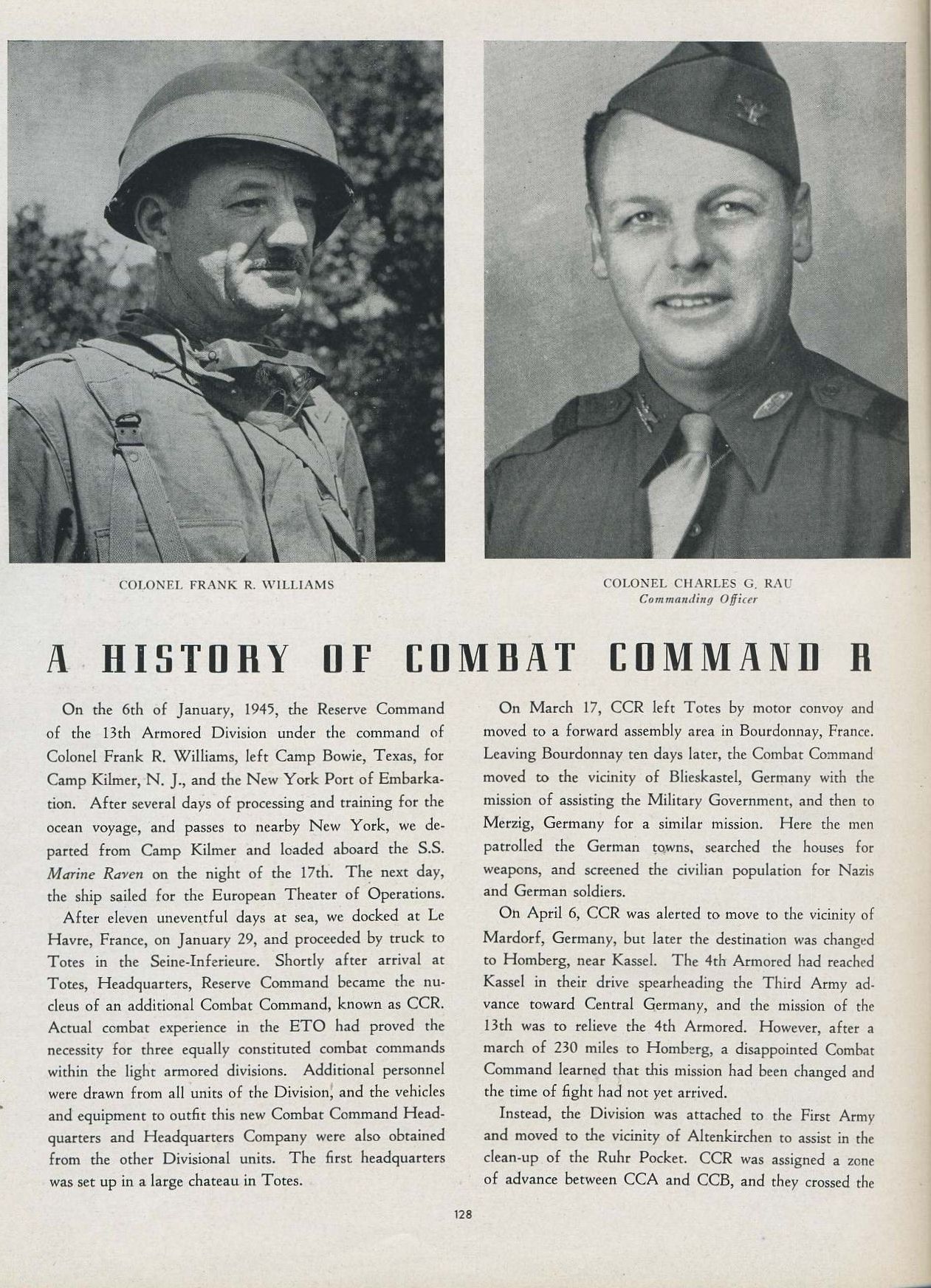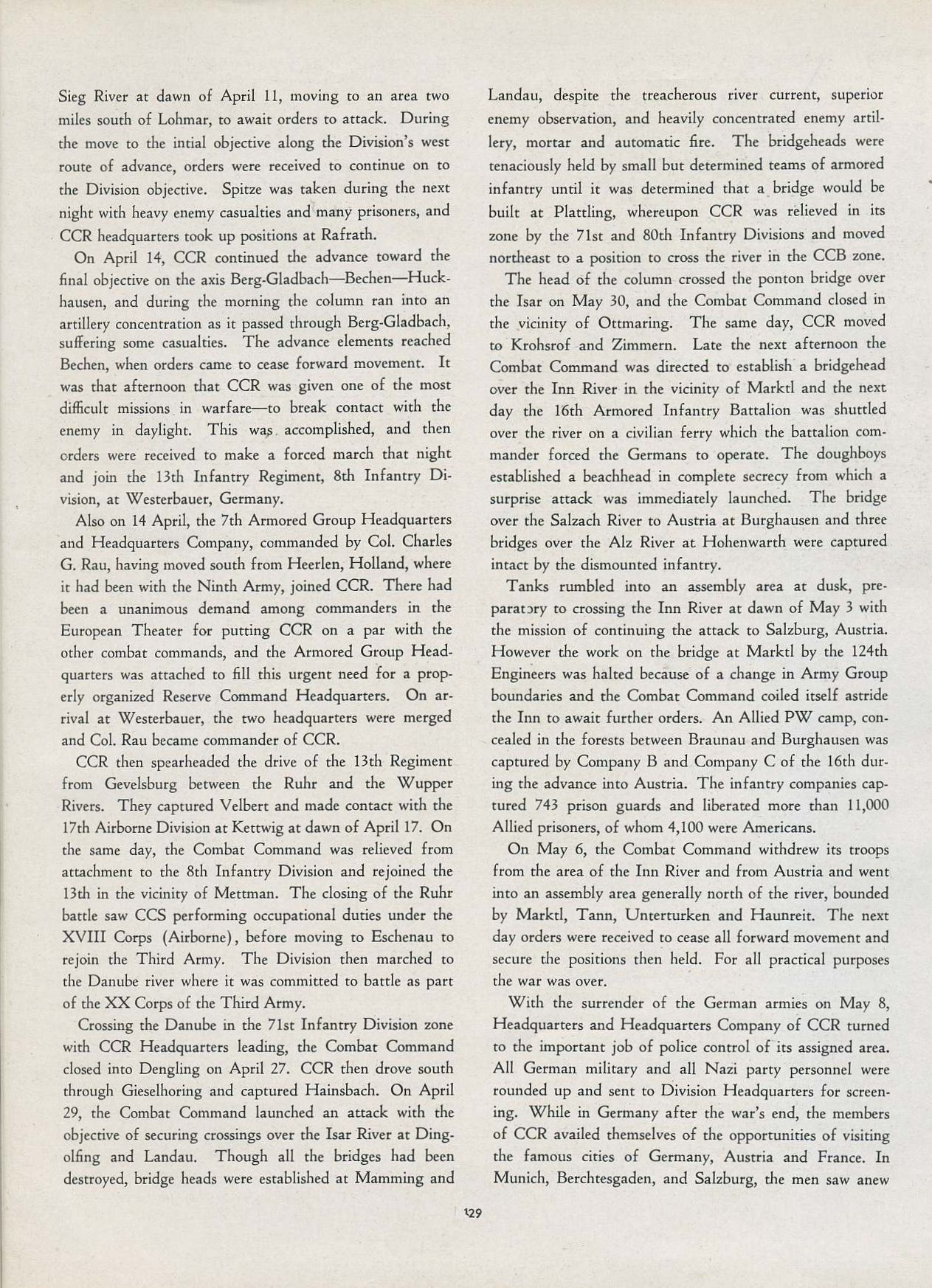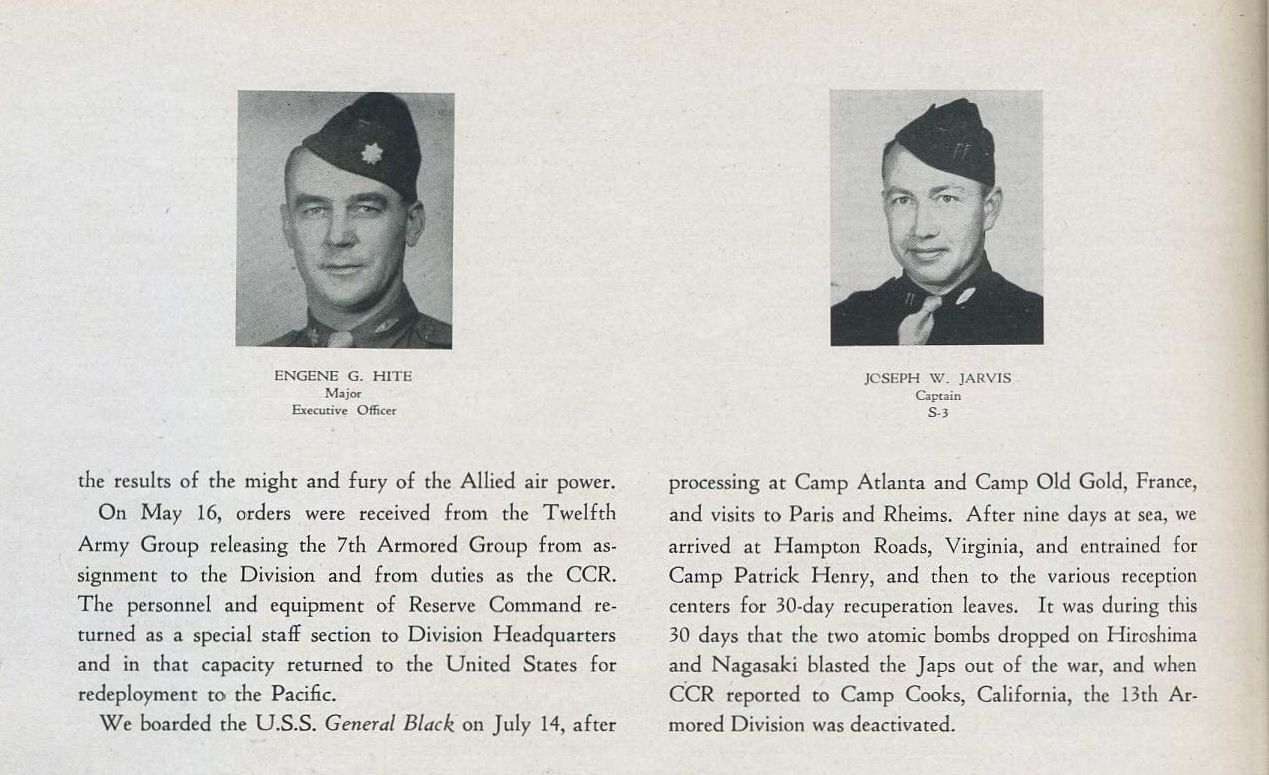Division Headquarters
Combat Command A
Combat Command B
Movements of Combat Command B
Combat Command R
____________________________________________________________________________________________________________________________________
SOURCE:
13TH ARMORED DIVISION – Division Headquarters
Copyright 1946, By the Division Headquarters, 13th Armored Division
Typography, engravings and printing by Army & Navy Publishing Company
Army and Navy Publishing Company Building
234 Main Street, Baton Rouge, Louisiana
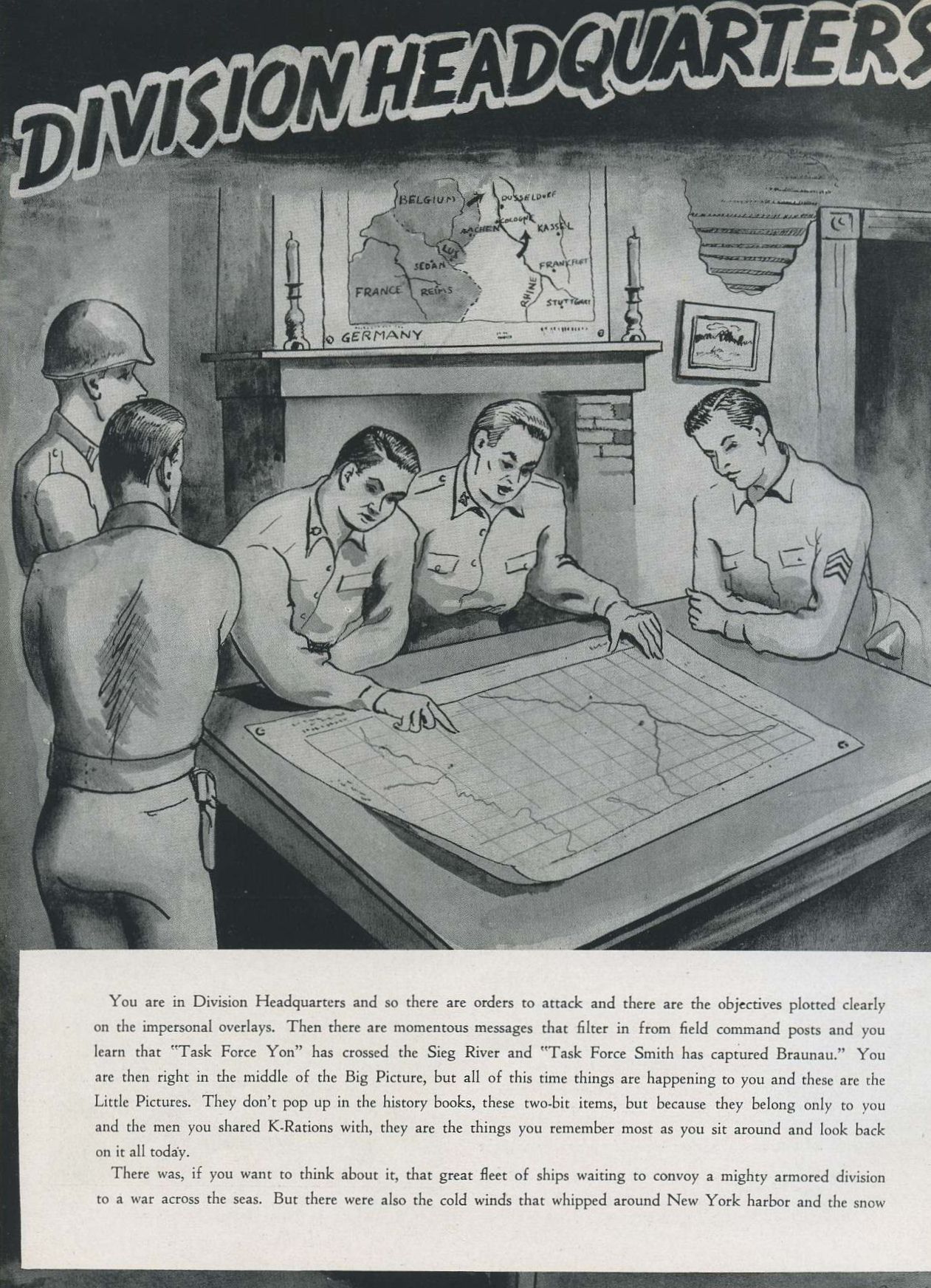
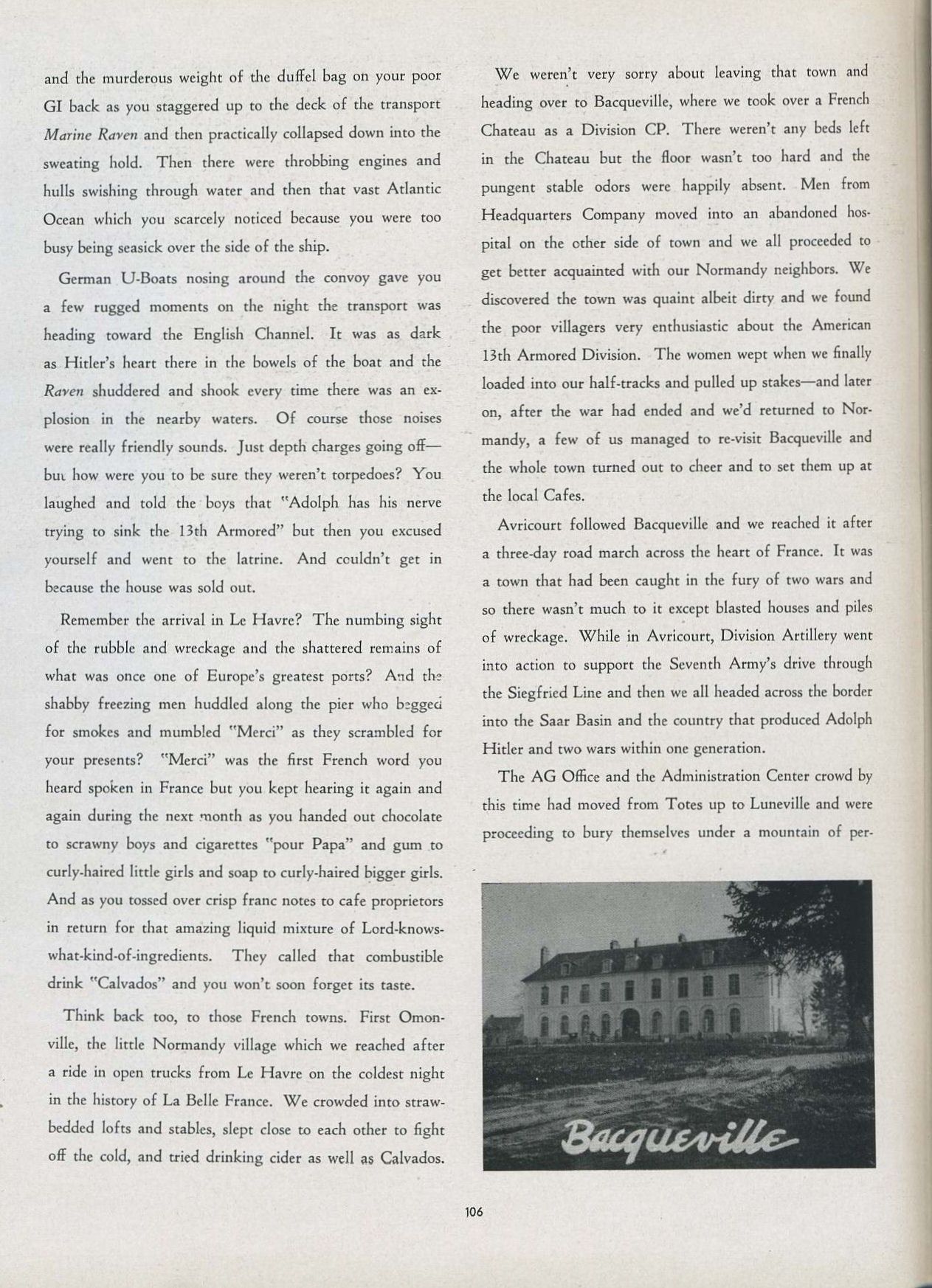
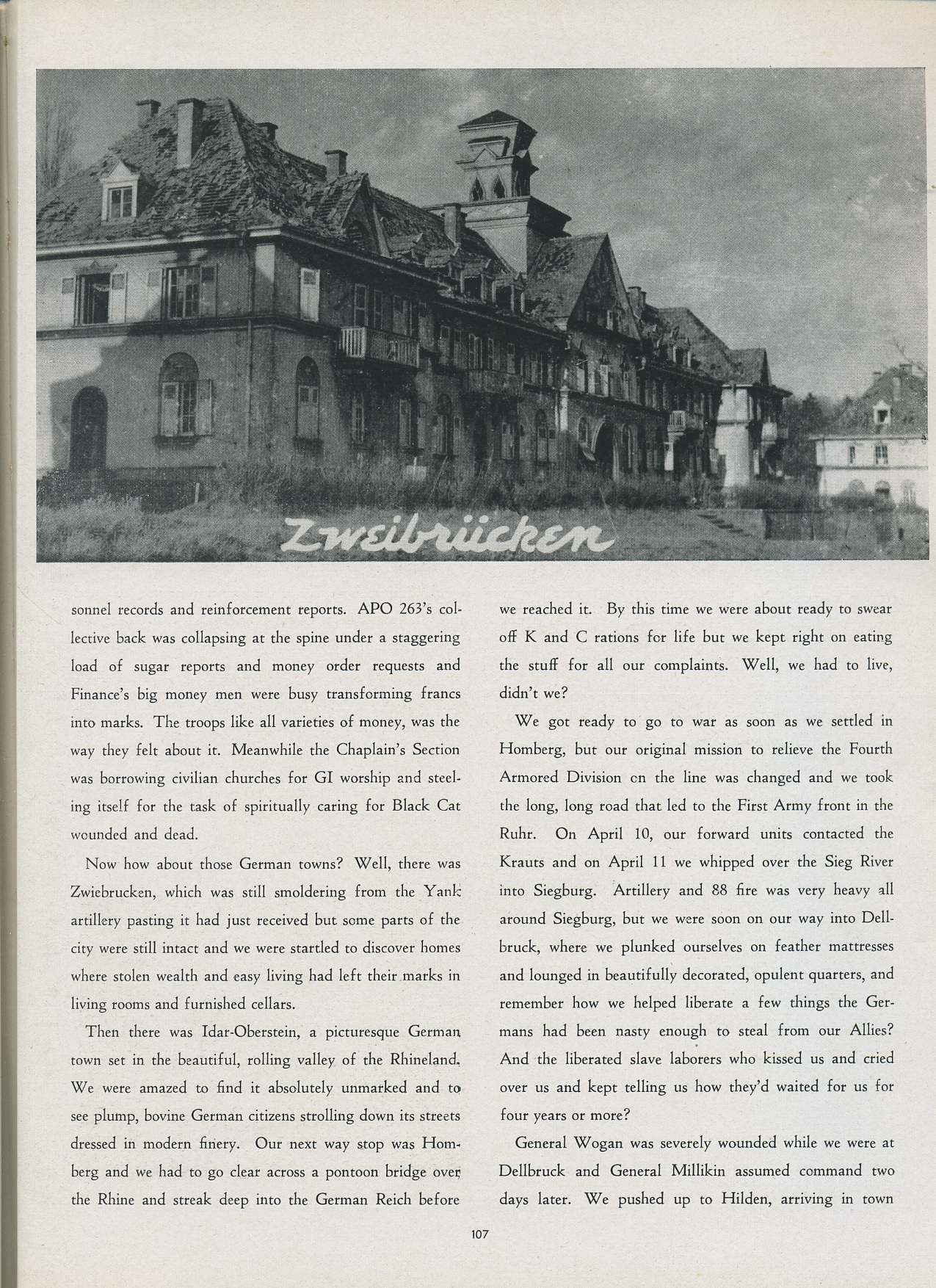
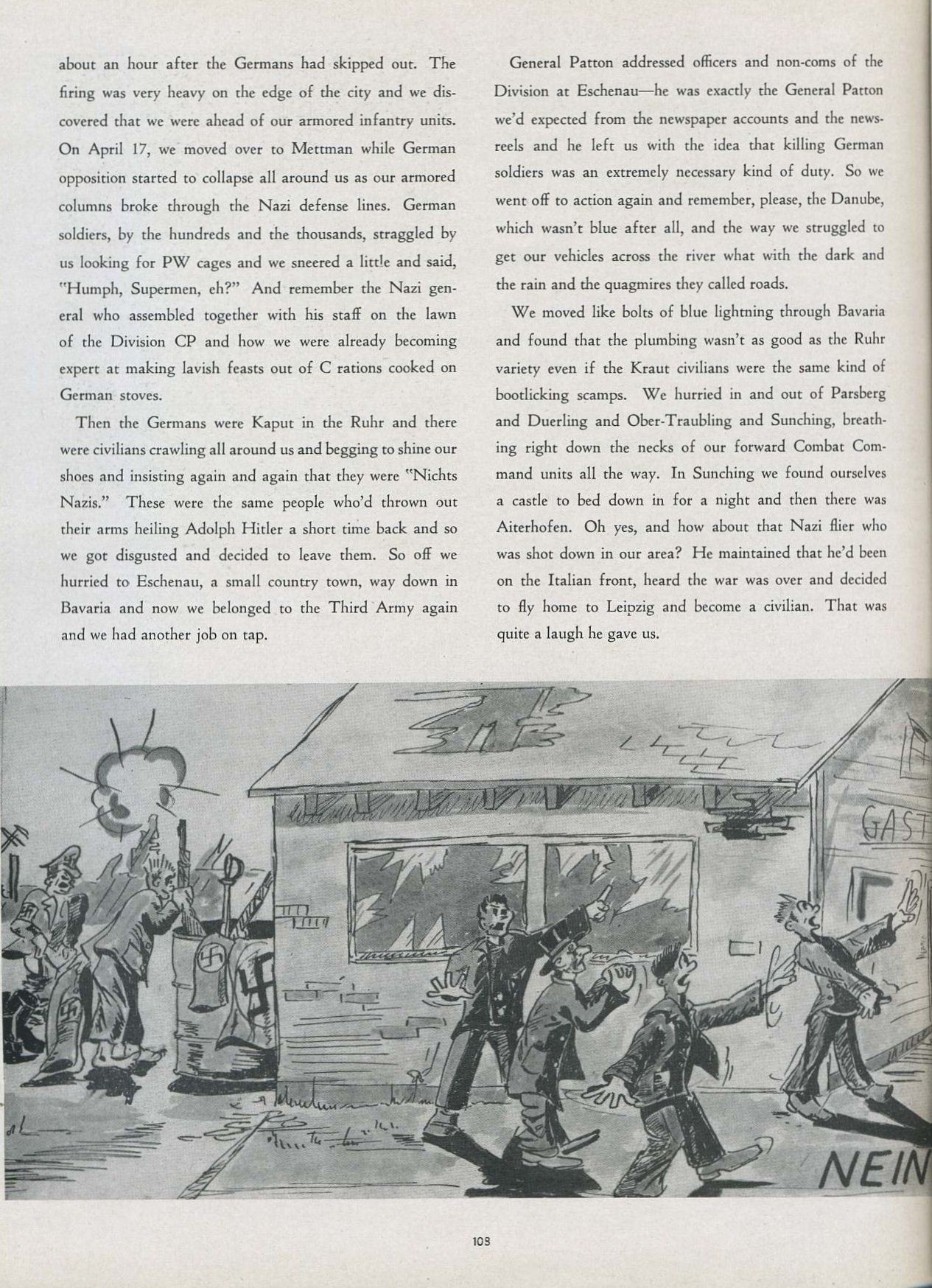
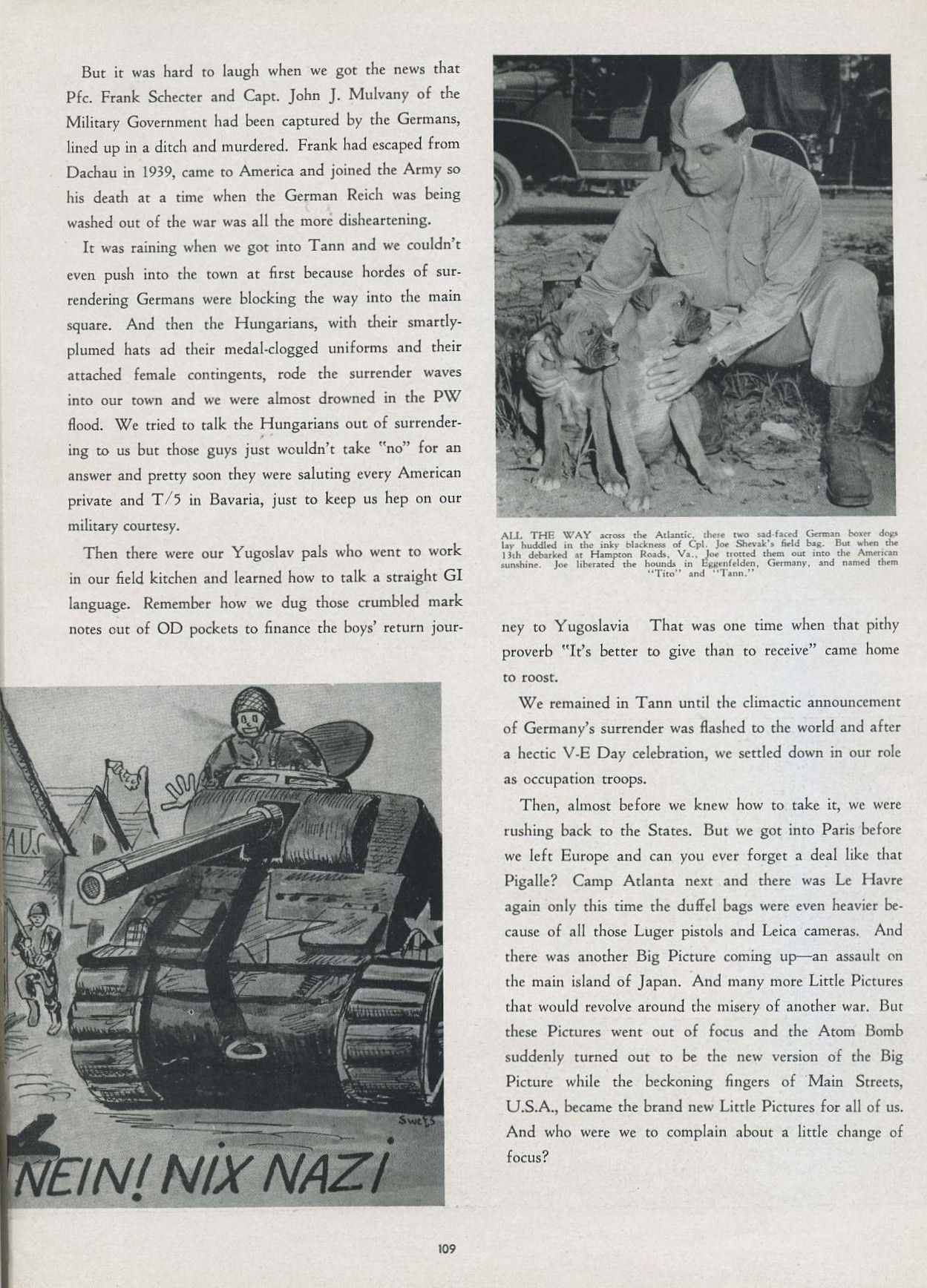
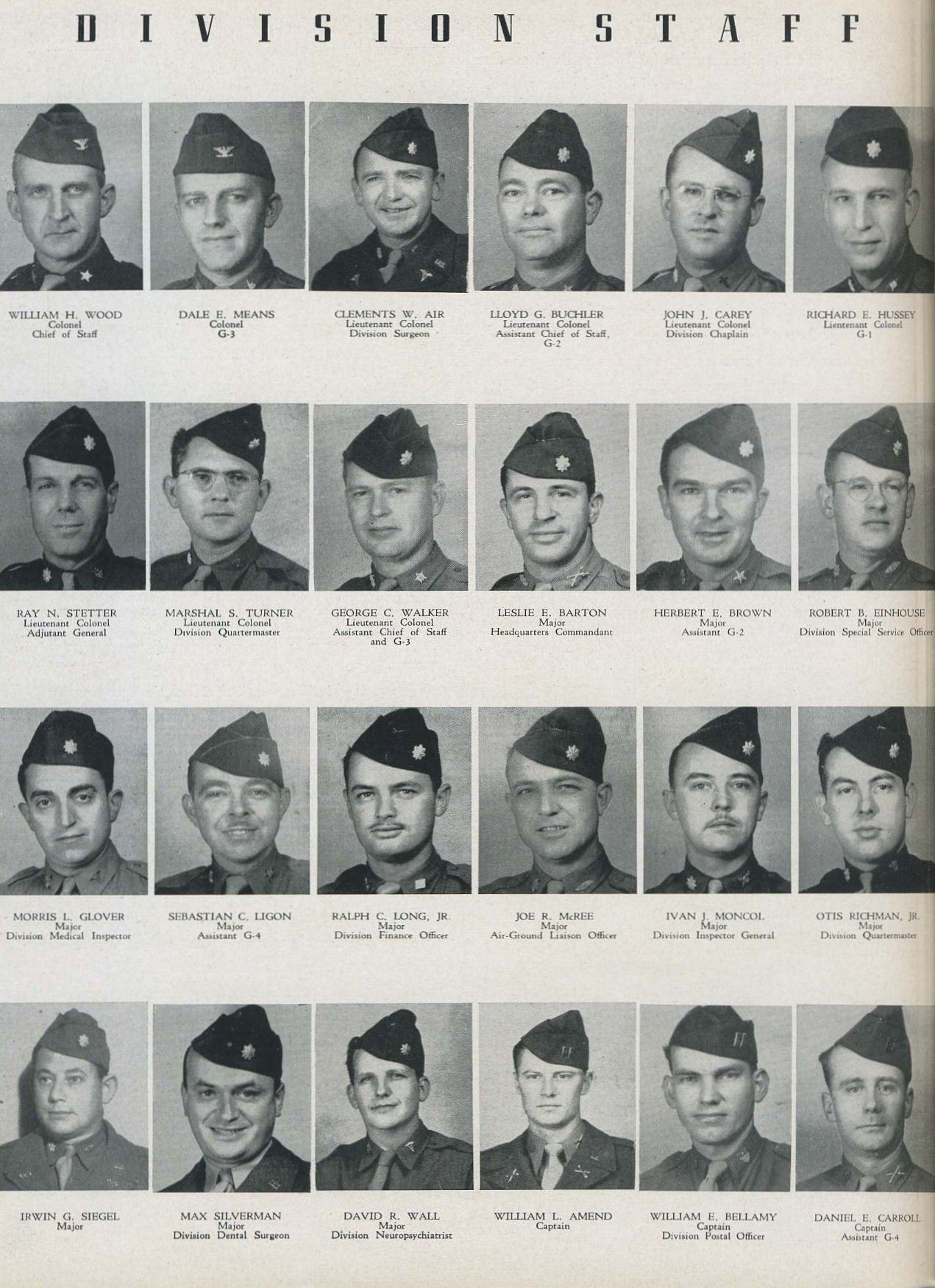
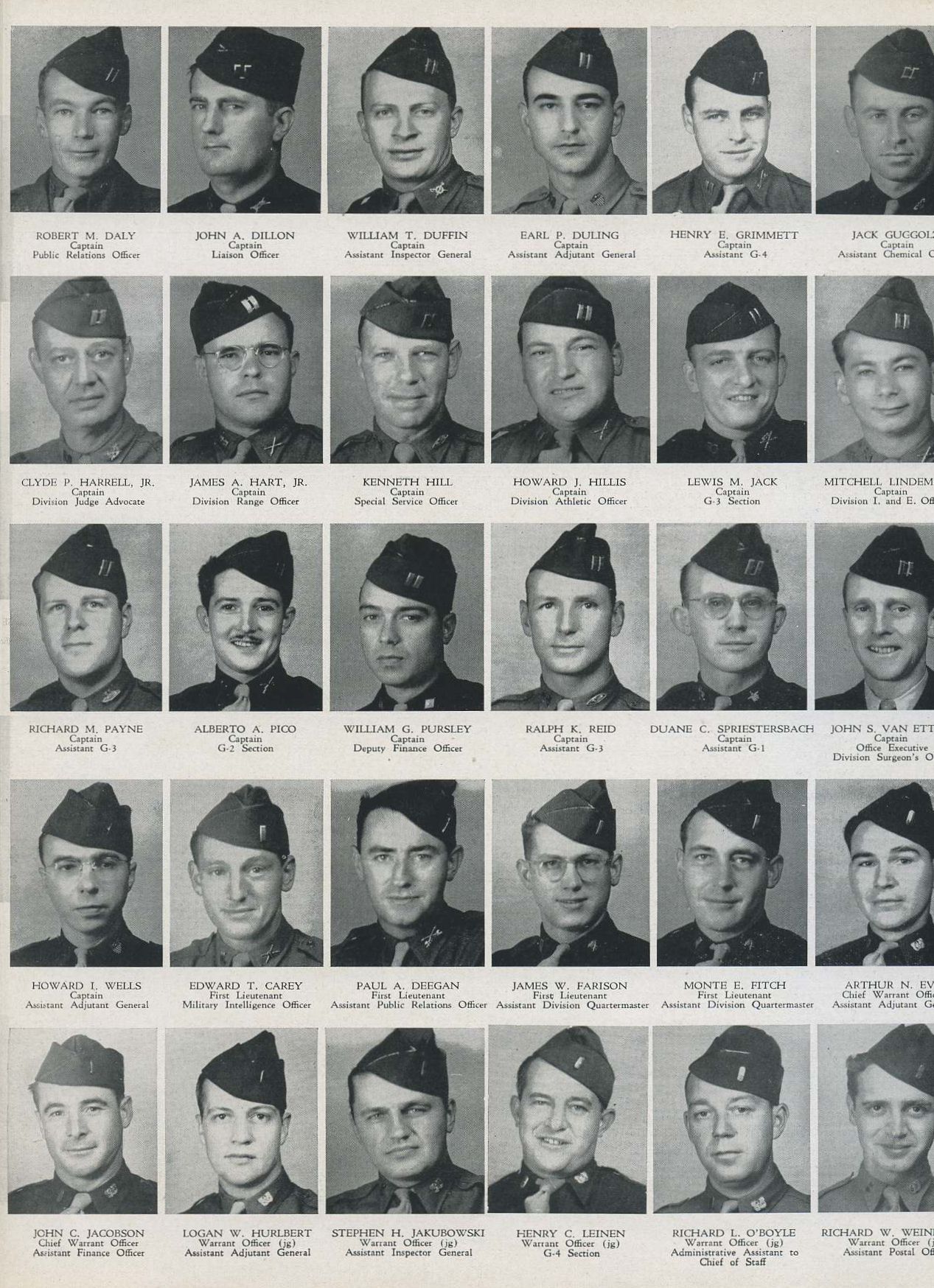
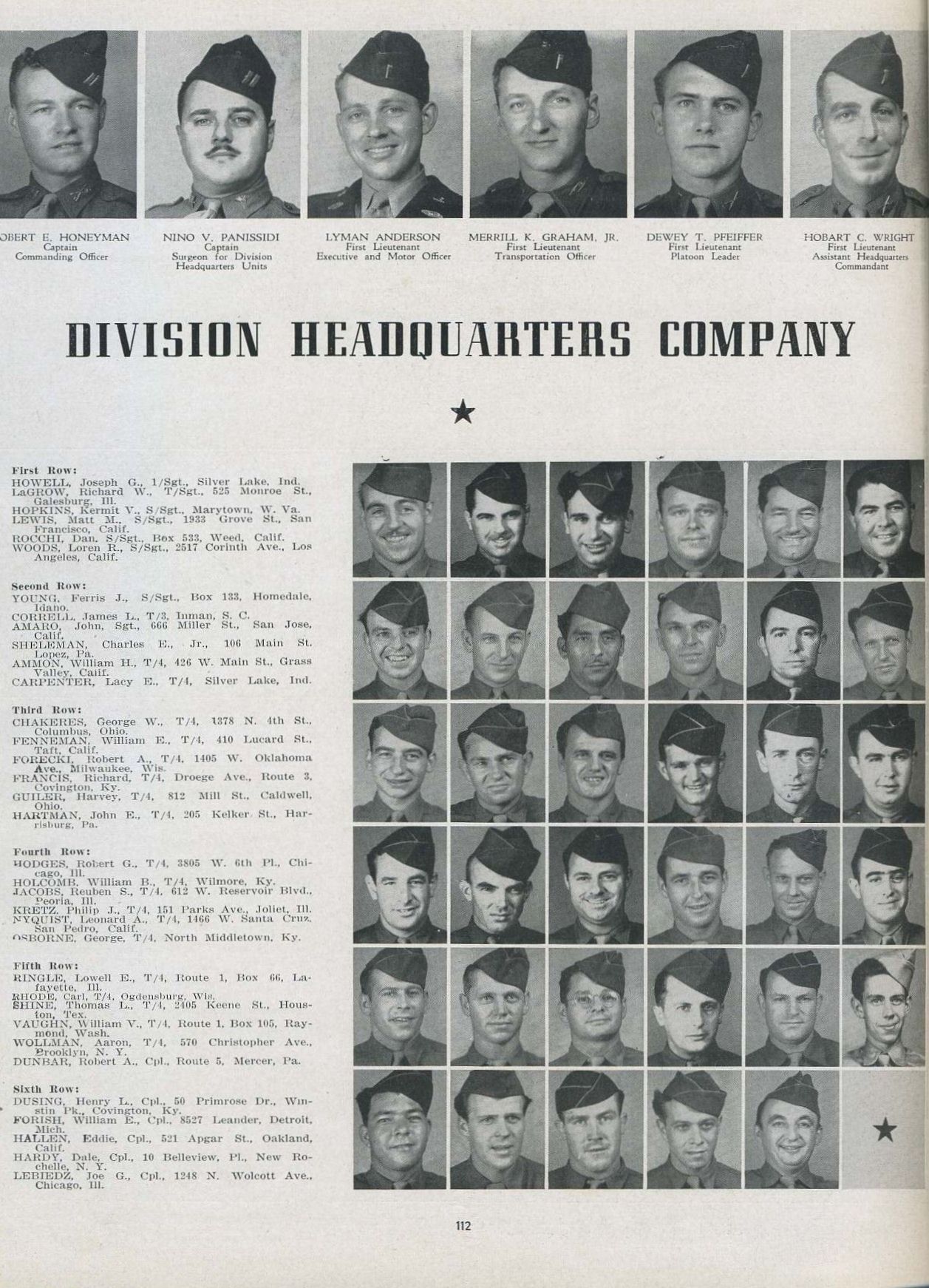
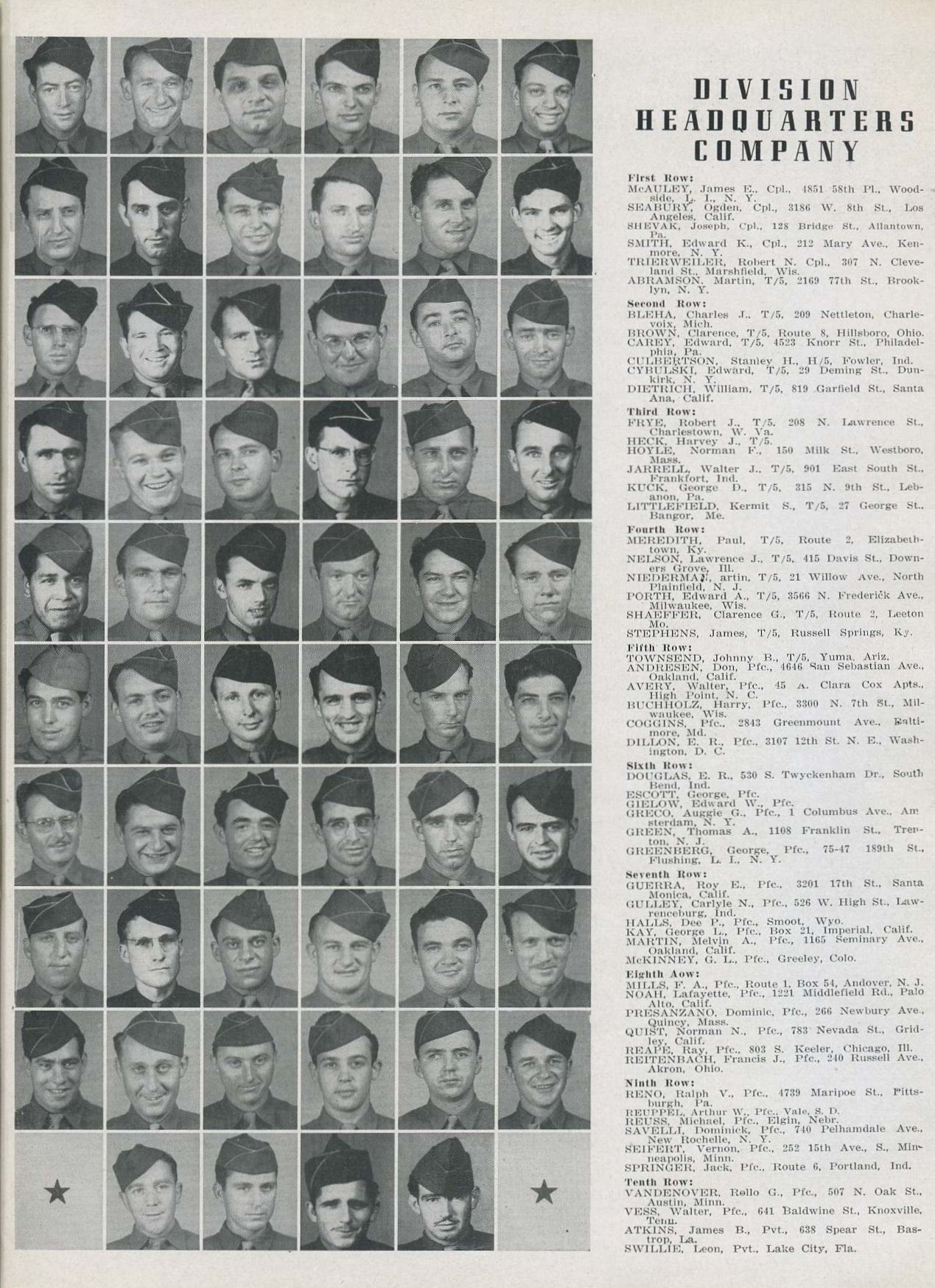
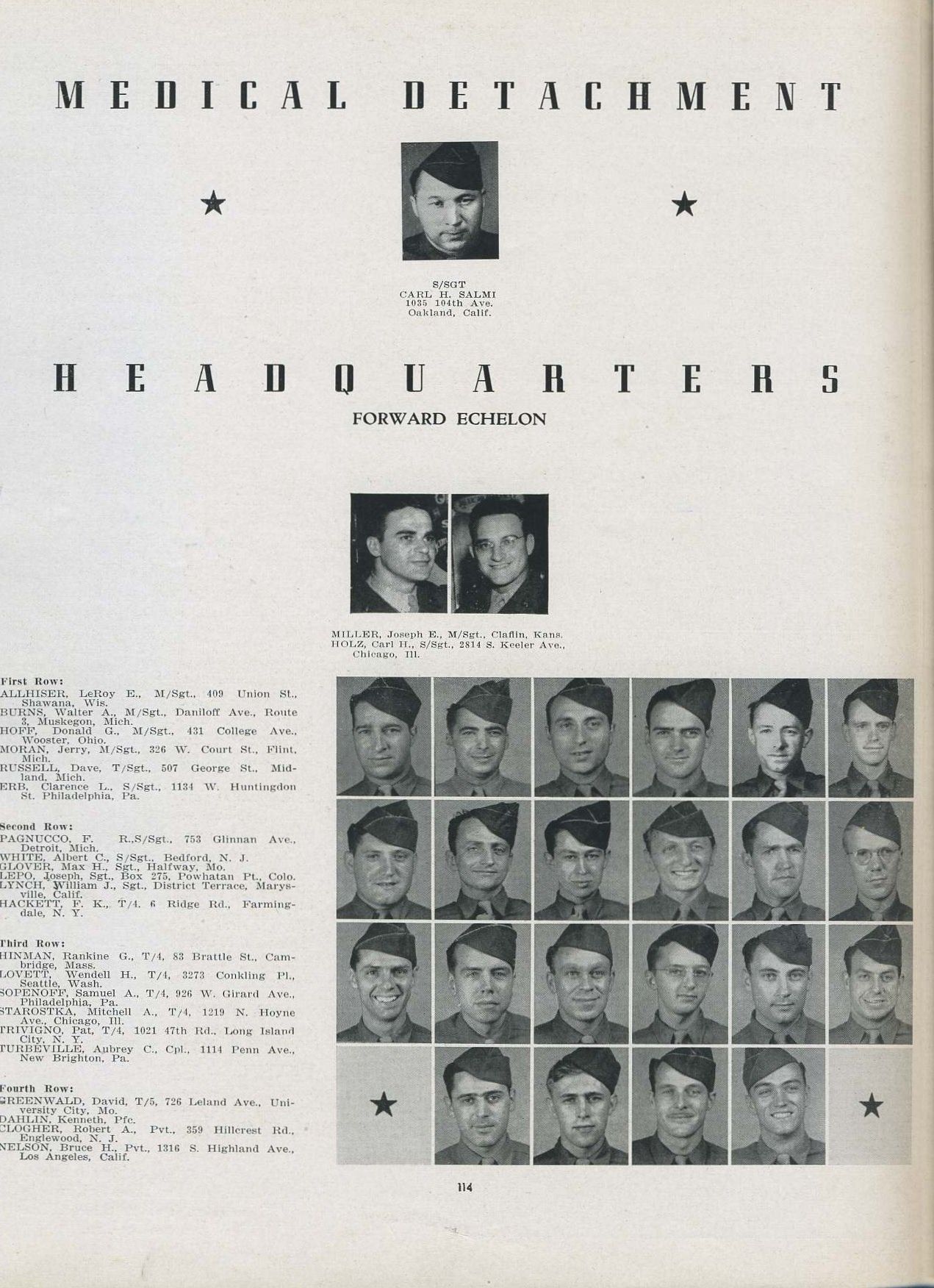
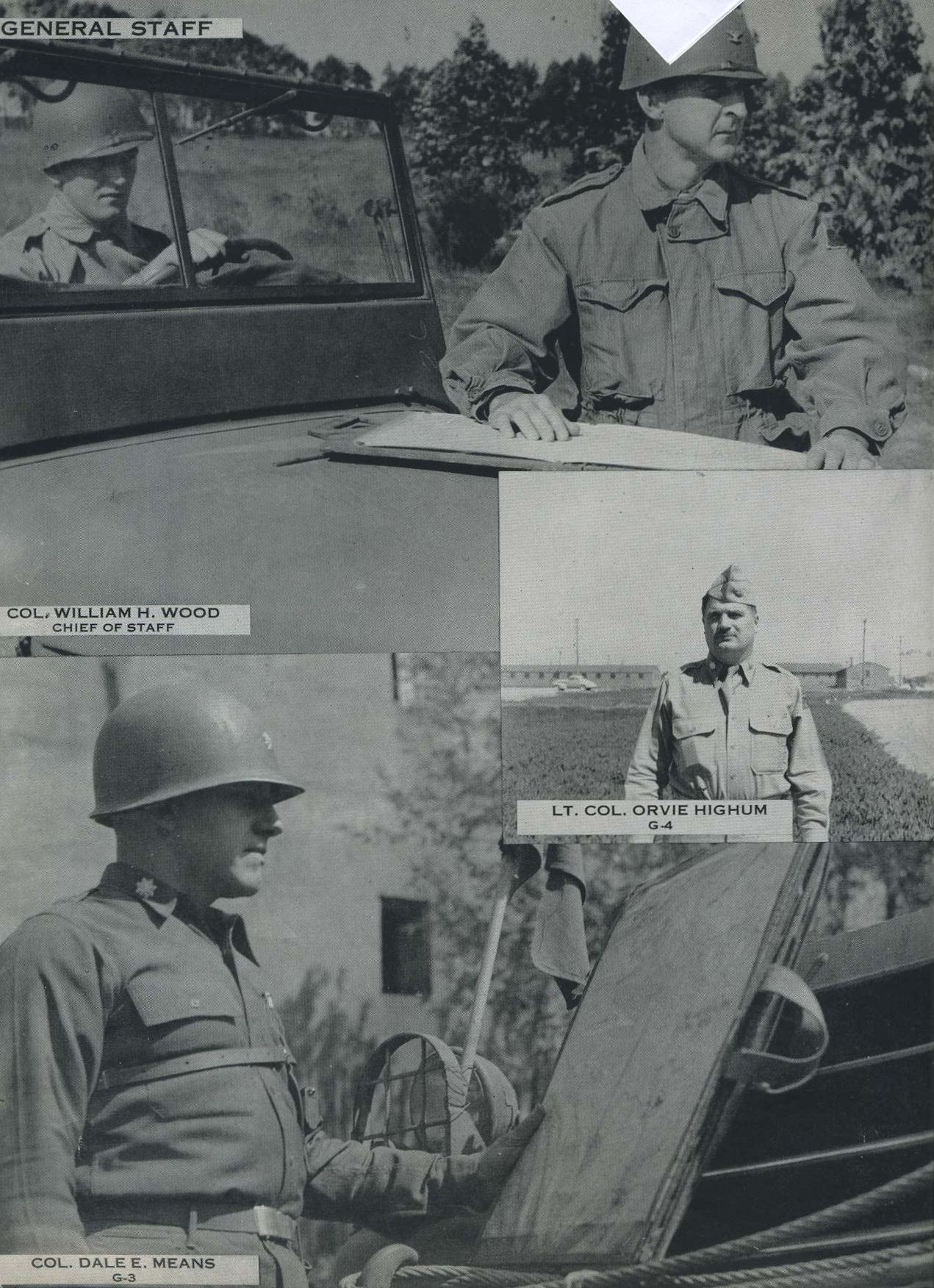
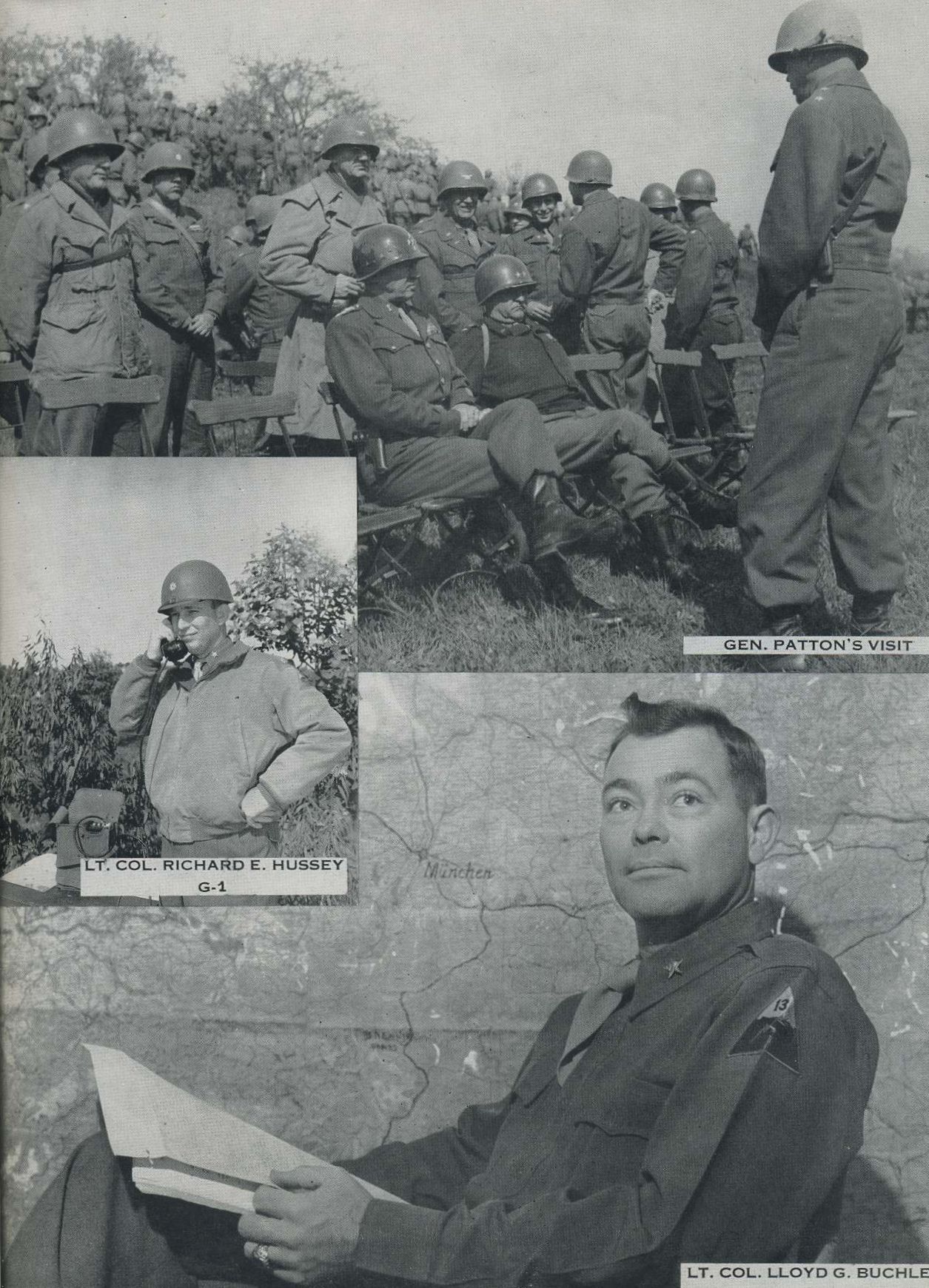
___________________________________________________________________________________________________________________________________
COMBAT COMMAND A
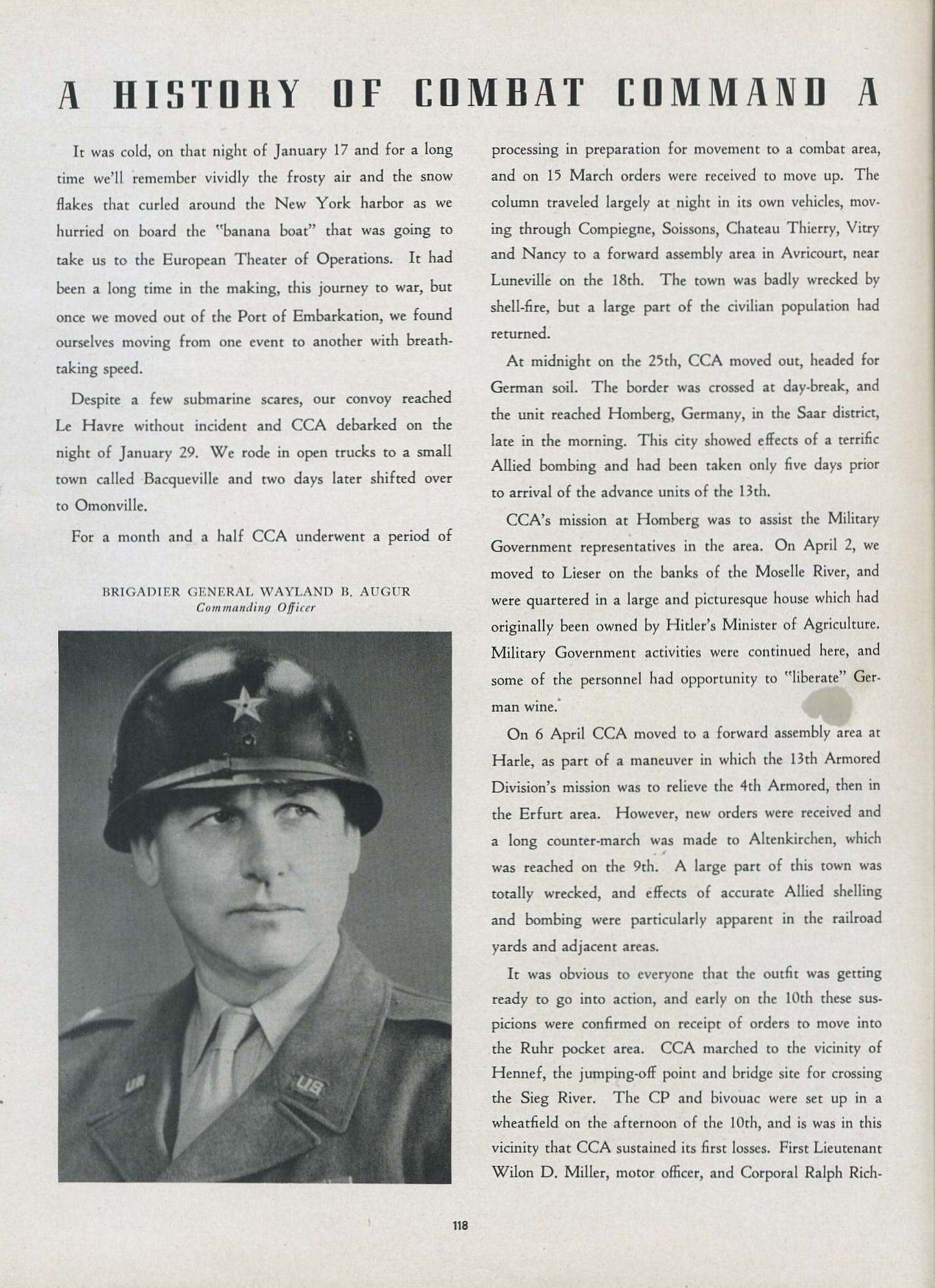
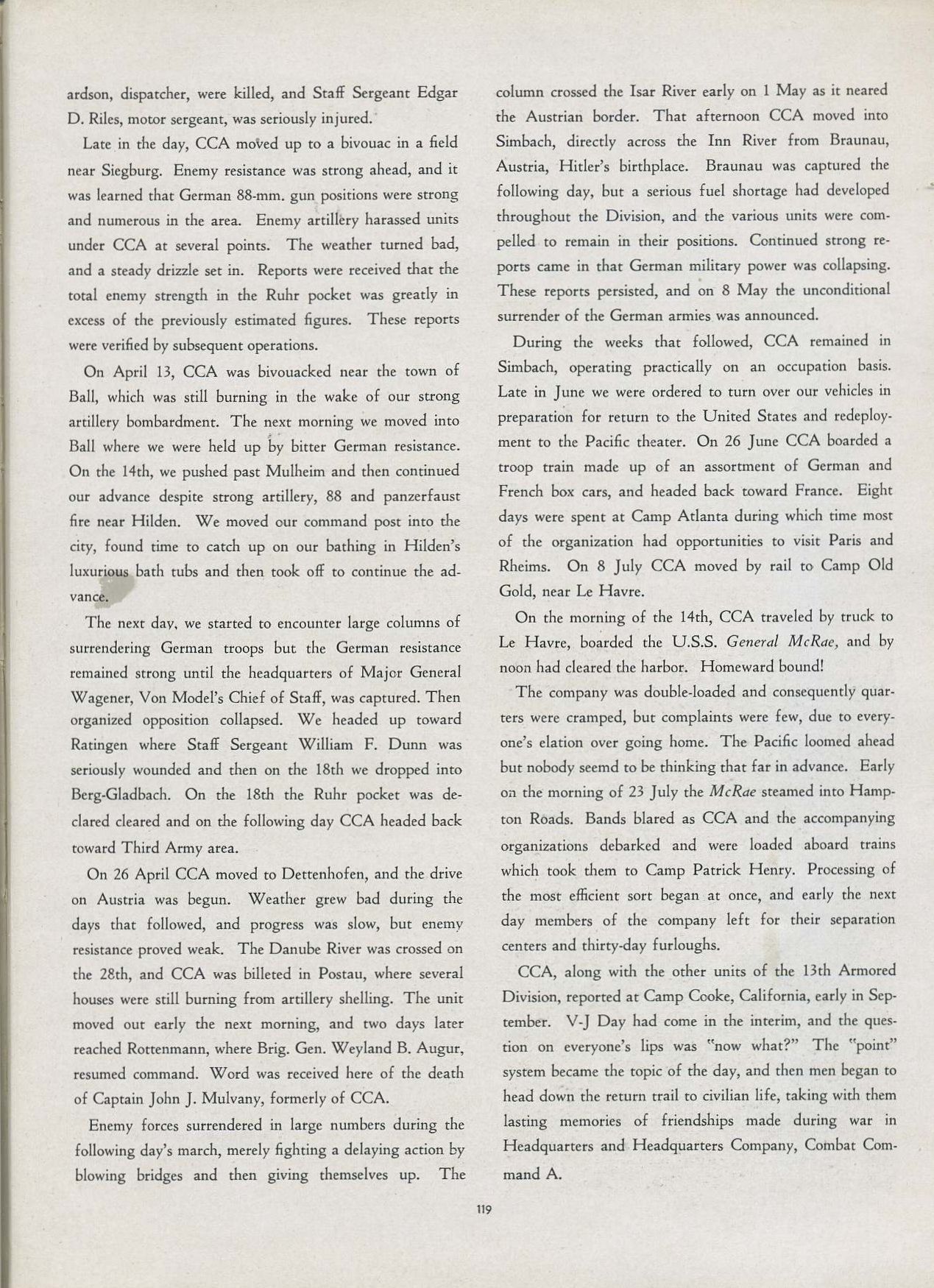
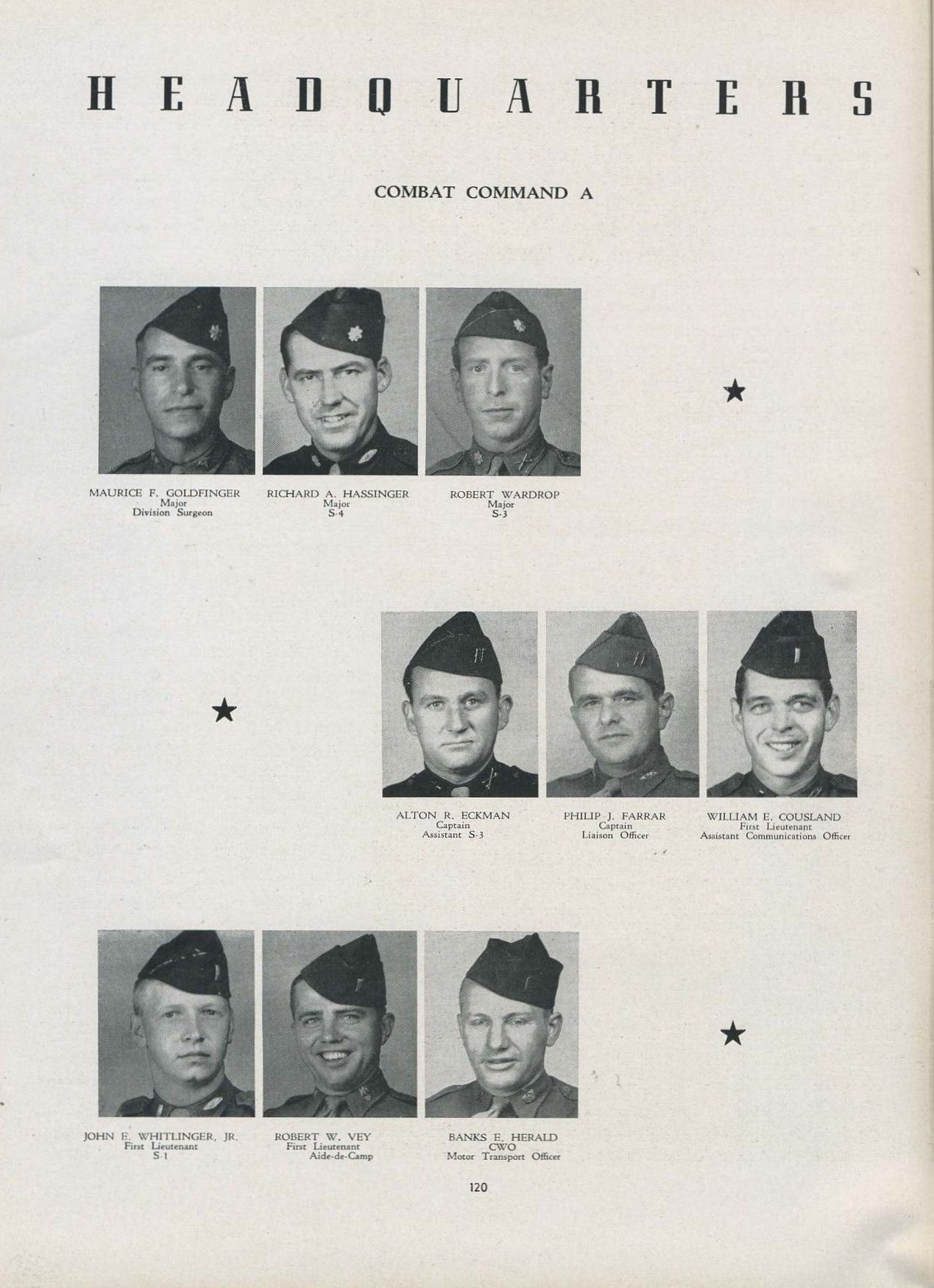
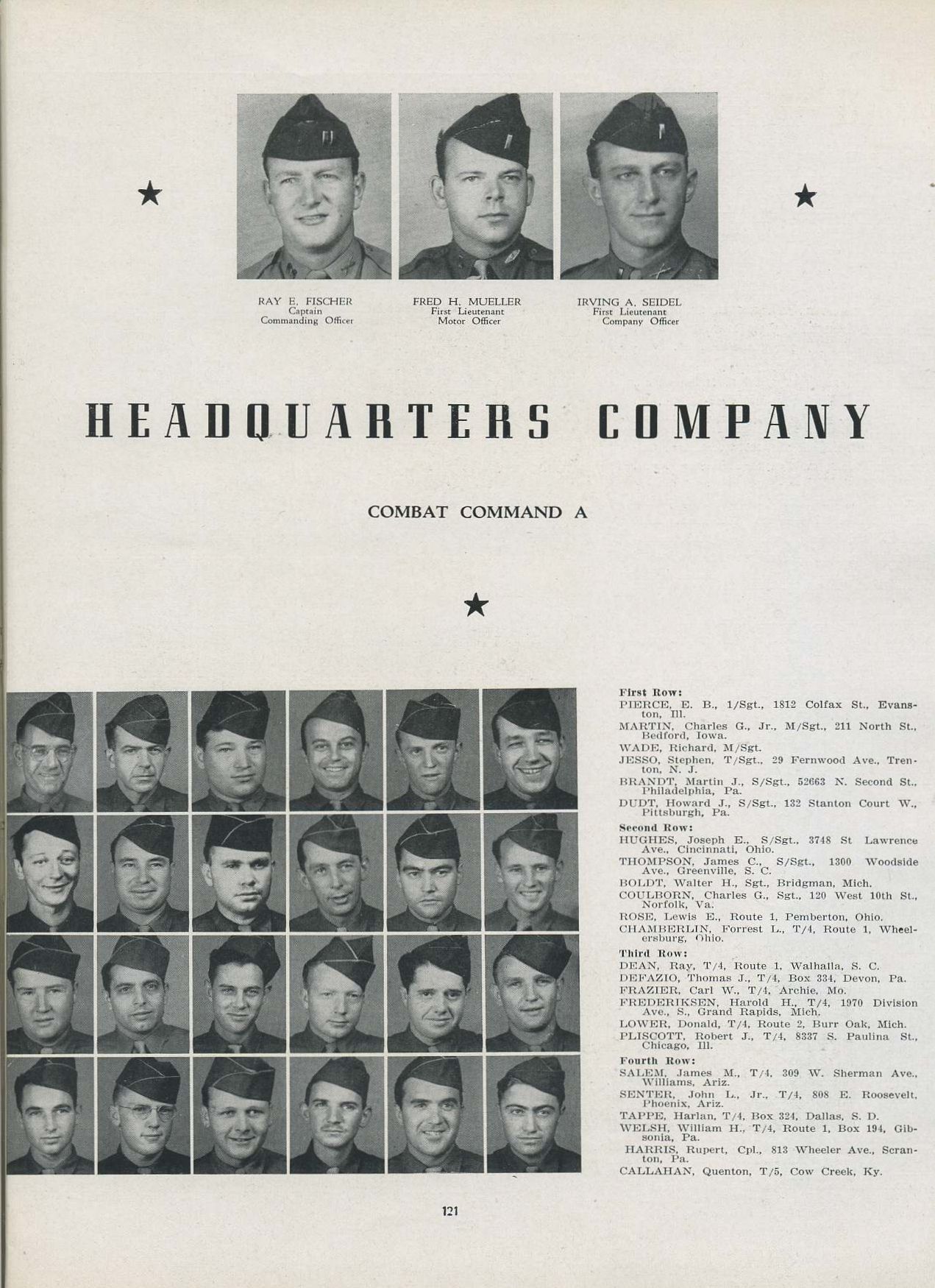
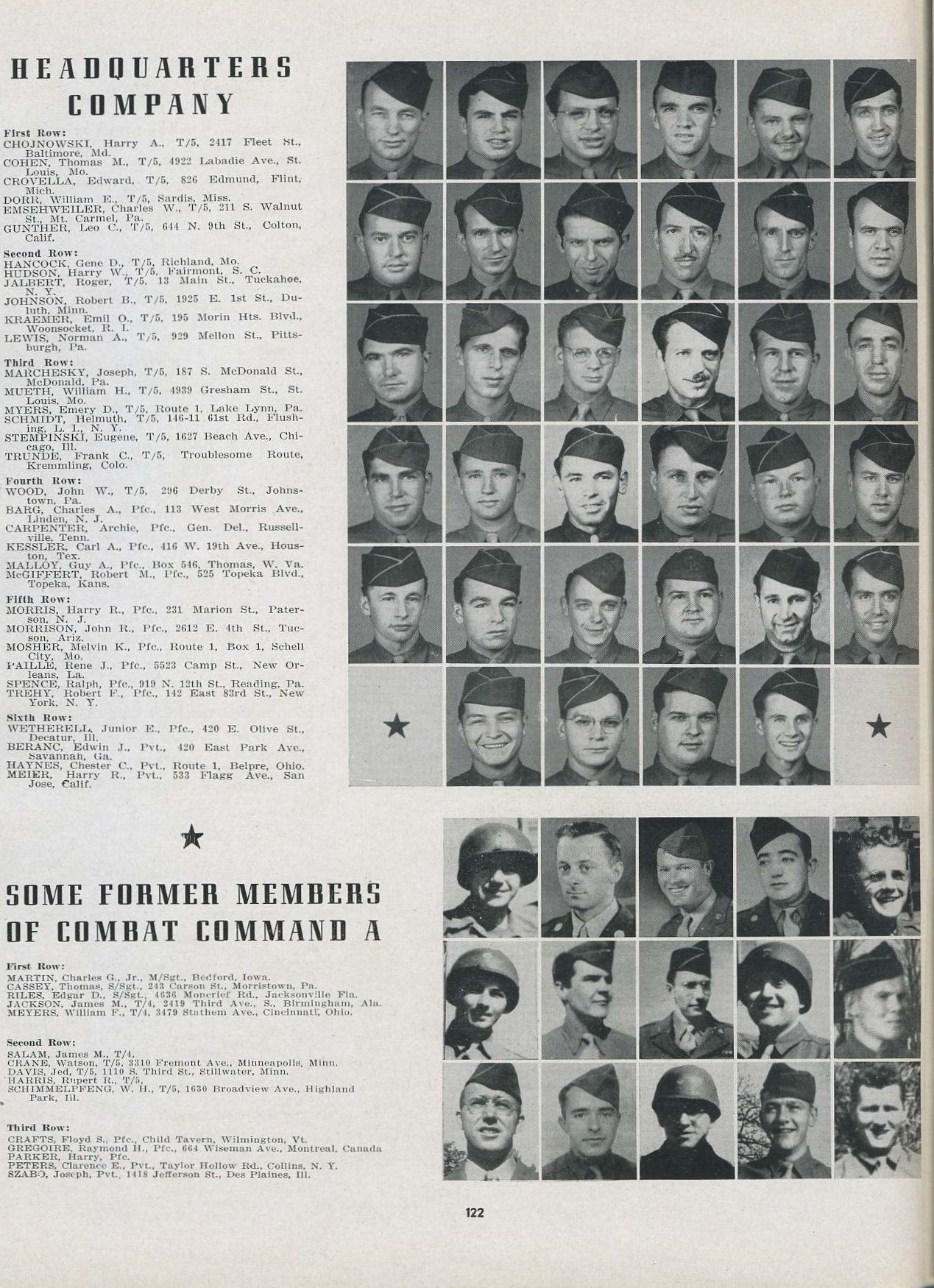
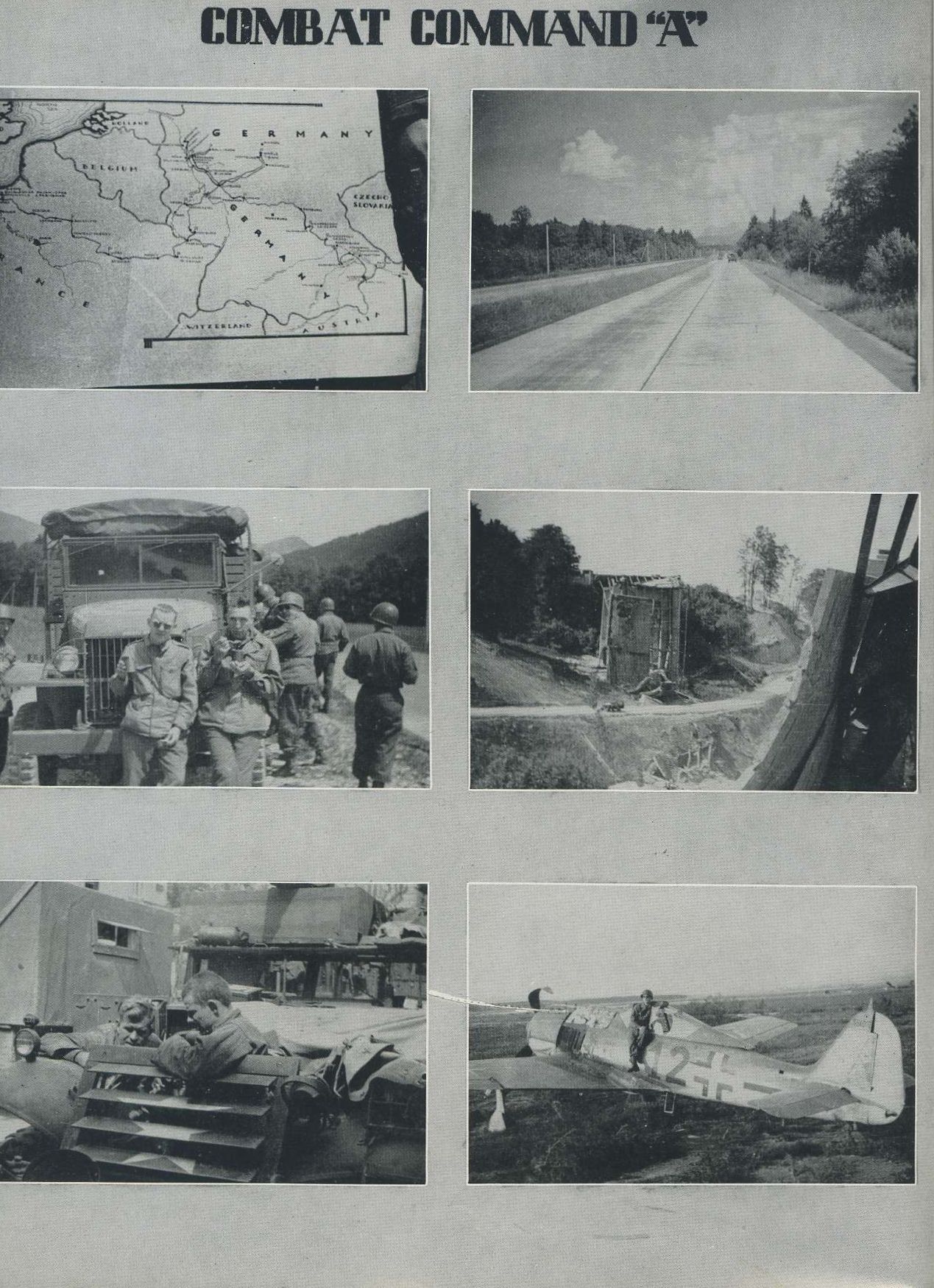
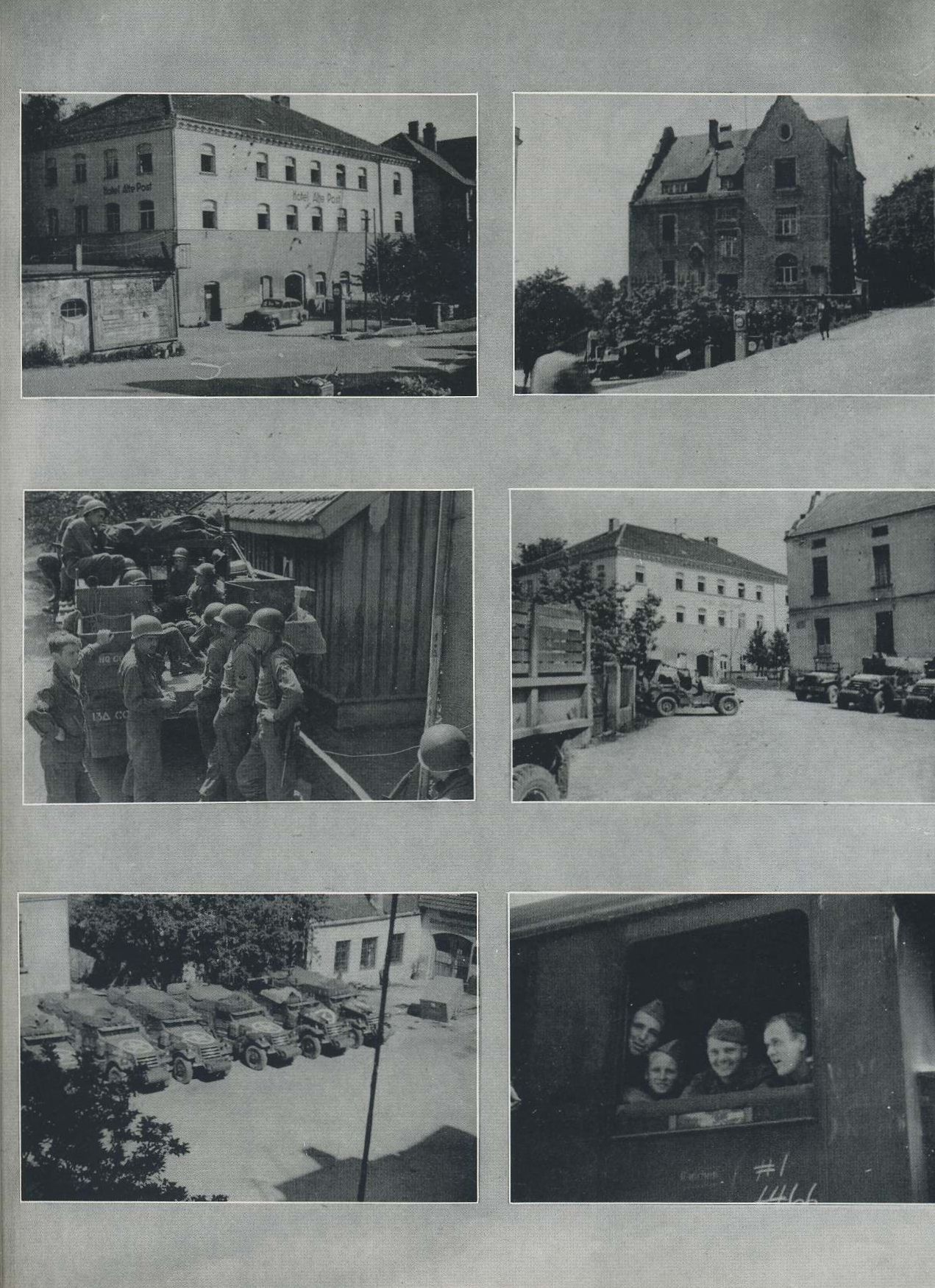
_________________________________________________________________________________________________________________________________
COMBAT COMMAND B
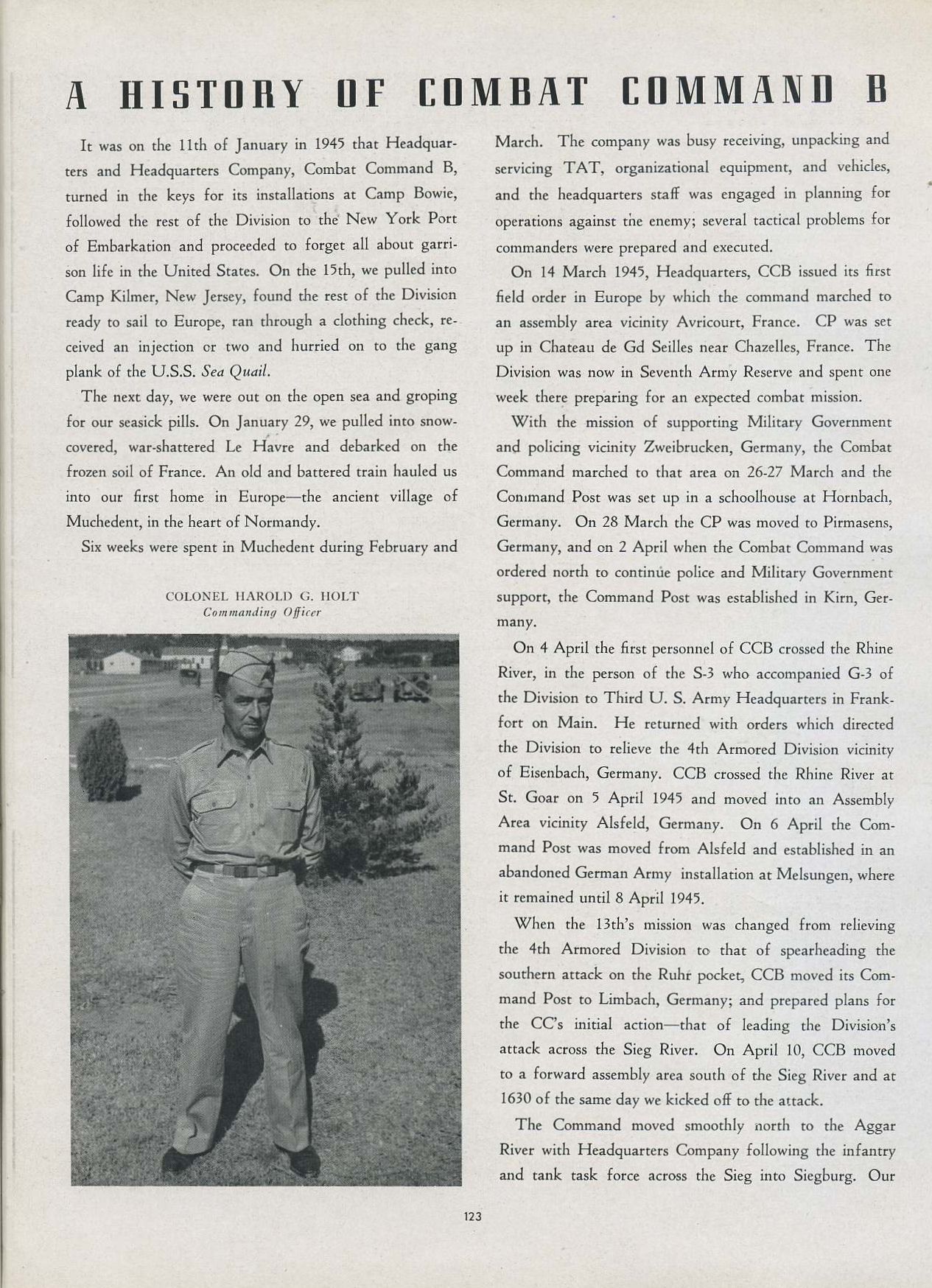
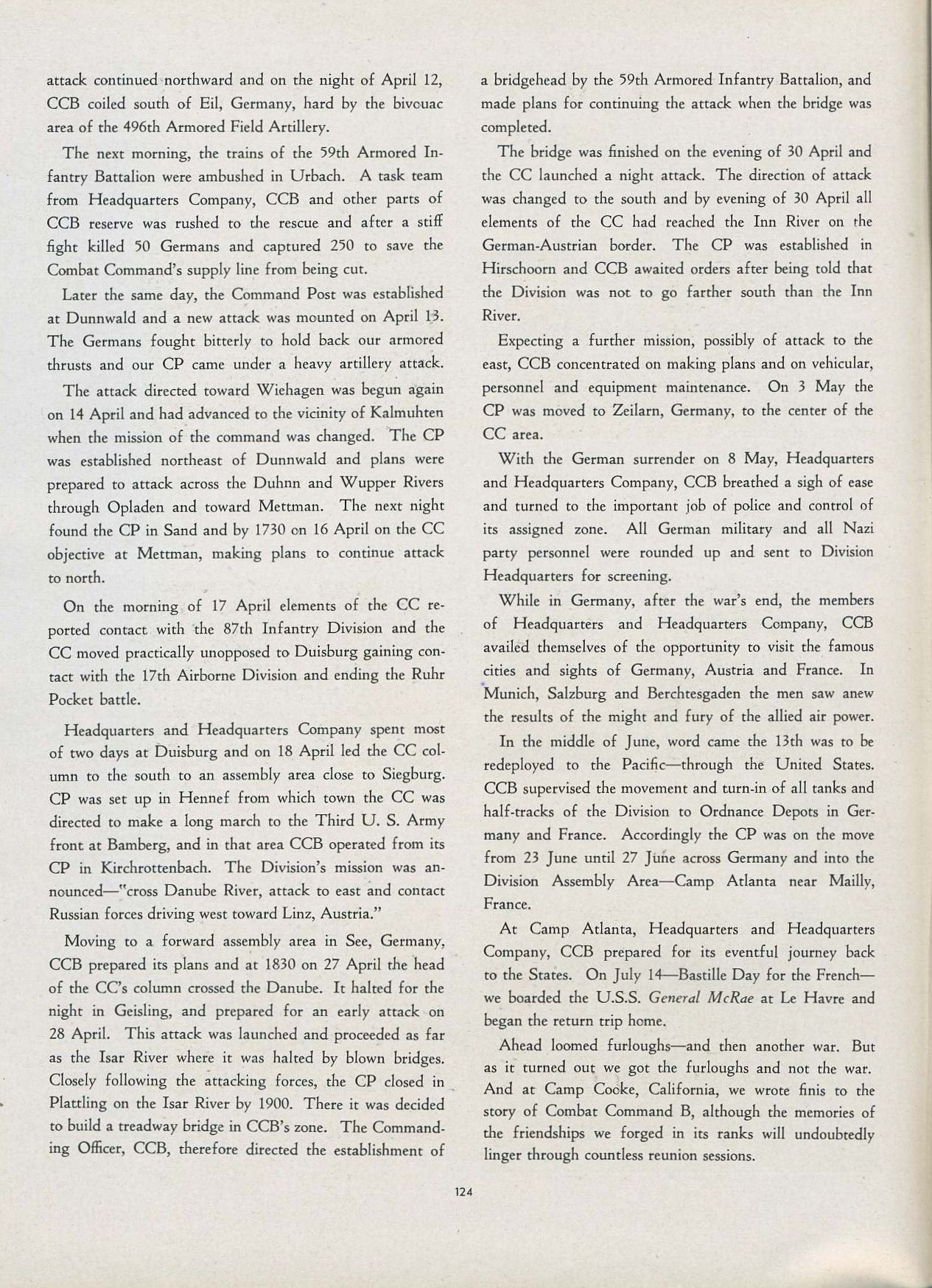
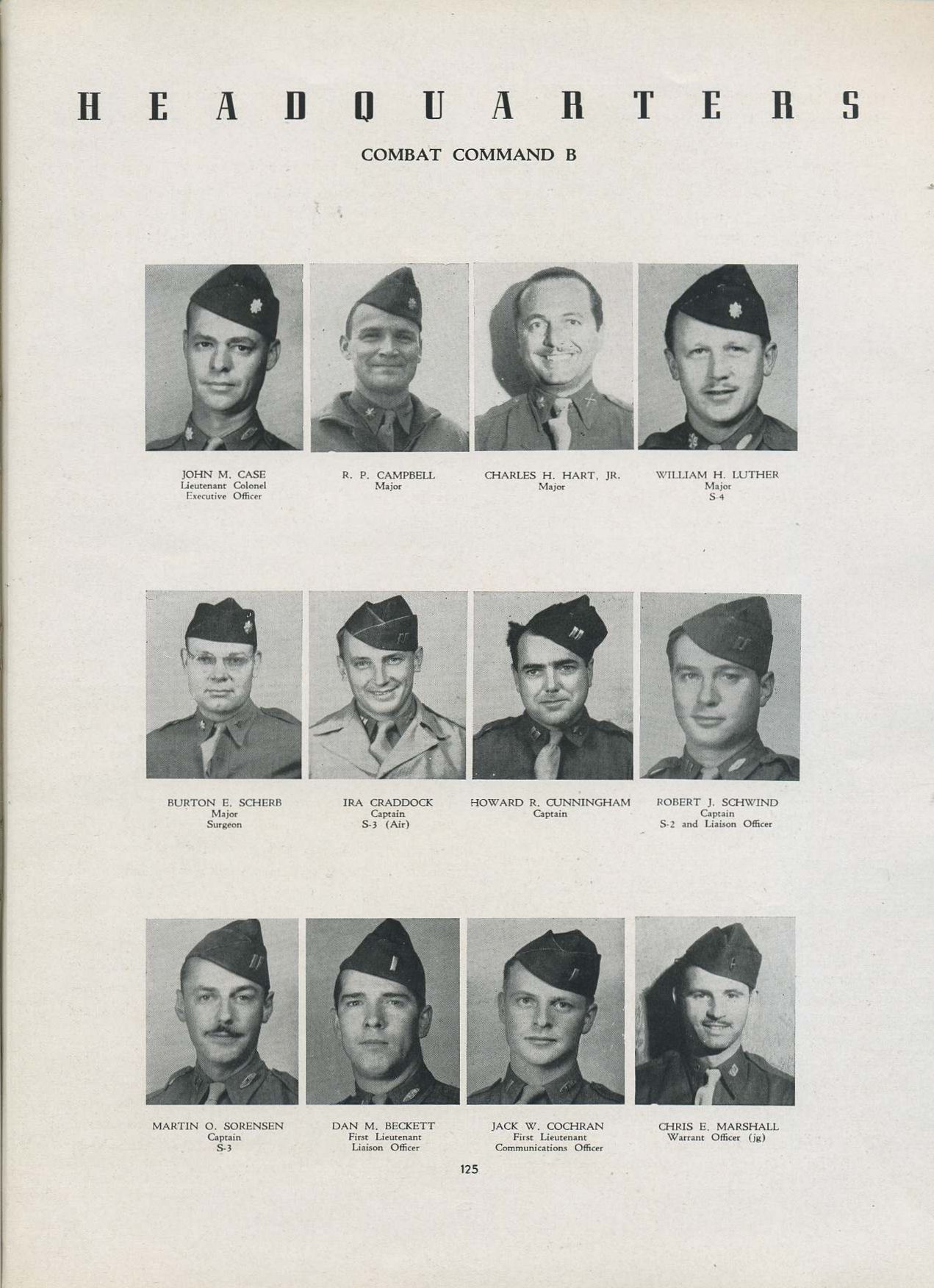
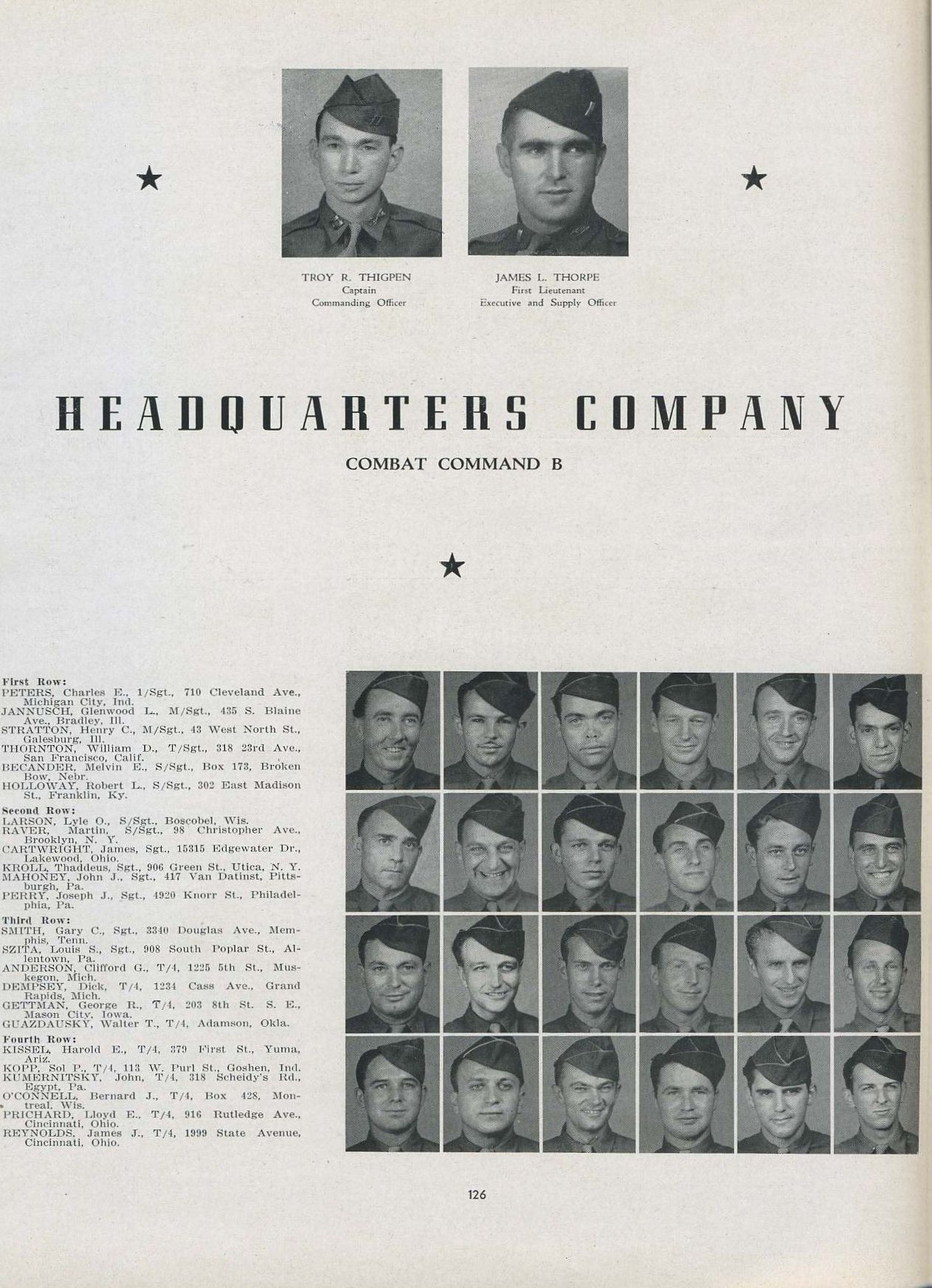
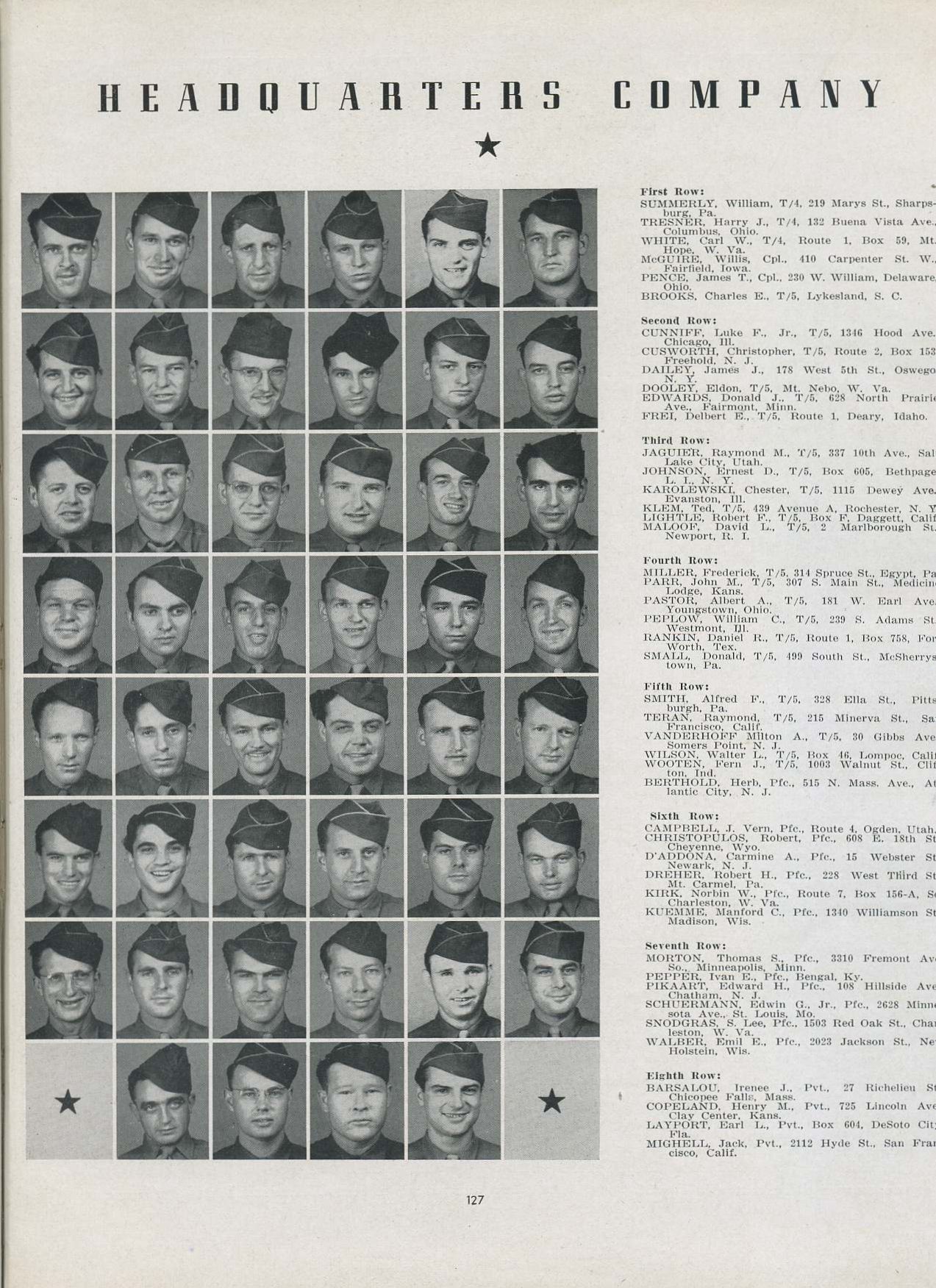
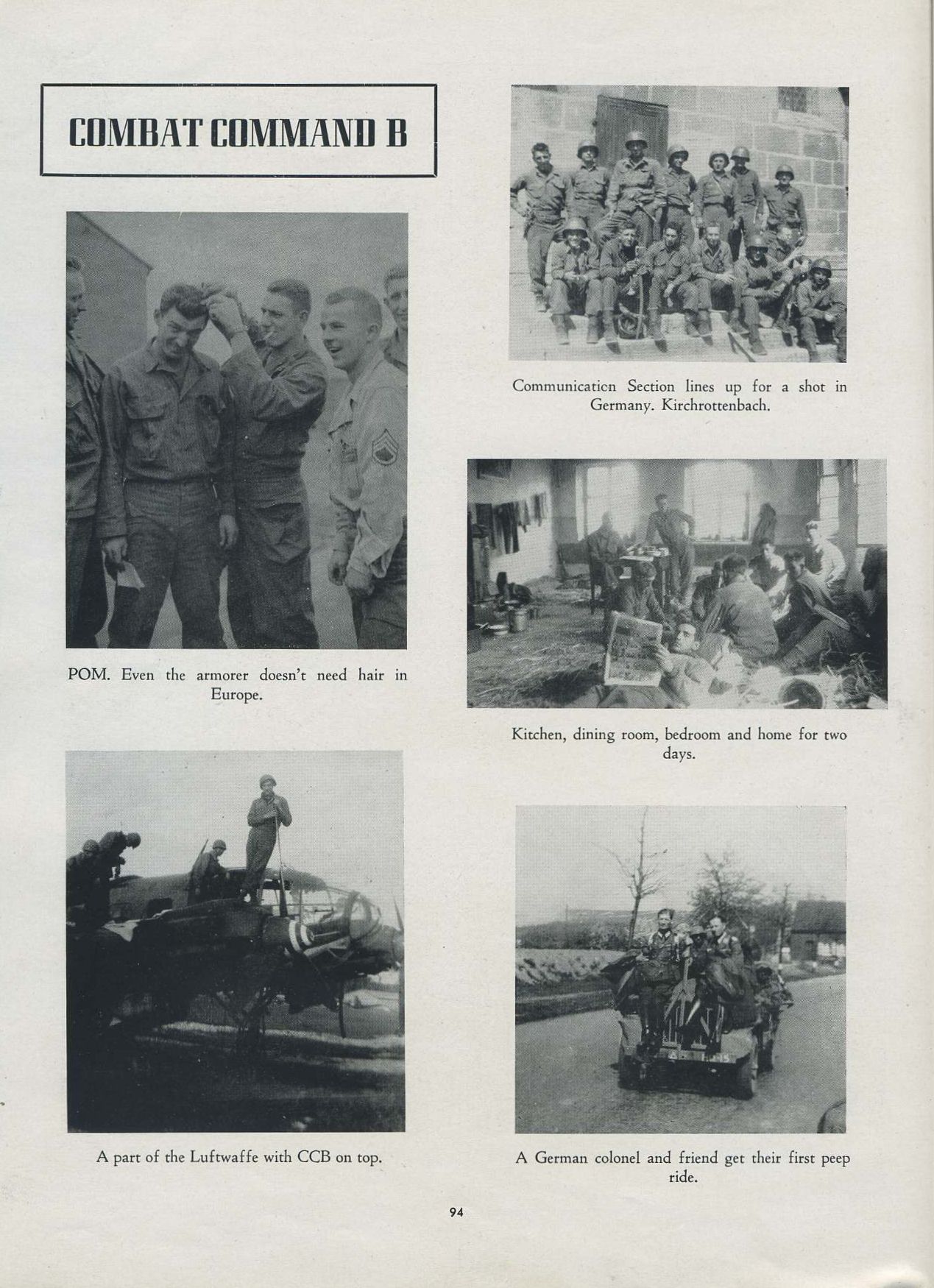
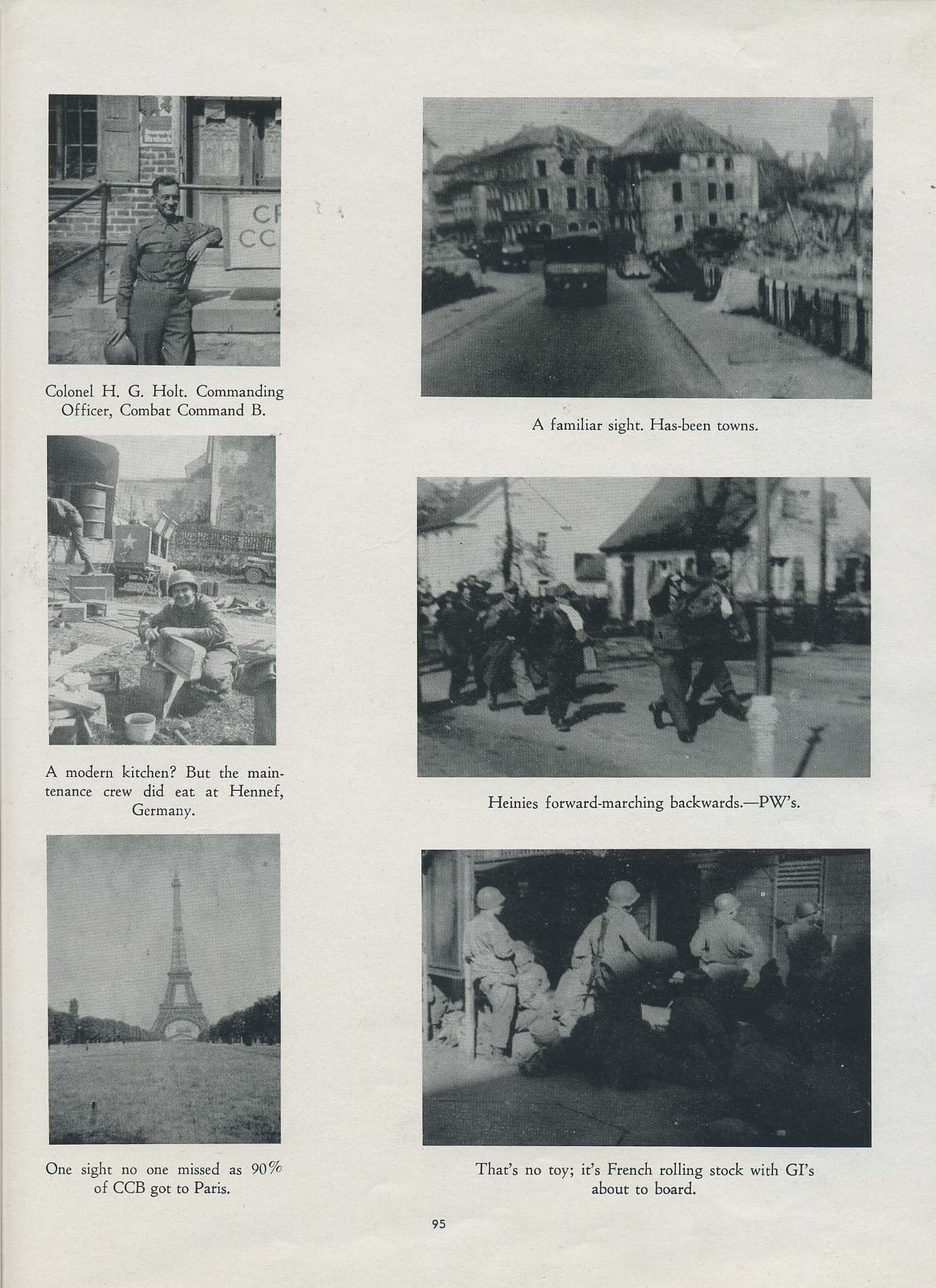
Tankers, Doughboys, Artillerymen, Cavalrymen, Engineers, Medics they are all here – and this is the recounting of their fighting
Lynn Polgar
This is the story of Combat Command ‘B’ of the 13th Armored Division. It is the history of its operations in the Ruhr and in Bavaria, its trials, tribulations and triumphs. The combat command comprised approximately one third of the Division’s fighting strength – one of its three battle groups.
Soldiers throughout the units of Combat Command ‘B’ of the 13th Armored Division listened in attentive silence on 7 May 1945 to the official proclamation of the cessation of hostilities in the European Theater of Operations, read by officers of their individual units. Moments of glee and loud celebration were followed by dreams of future prospects and moments of reminiscing on the action -packed days of the Combat Command’s battle experiences in cleaning out a huge pocket in the Ruhr Valley and the Bavarian campaign. And thoughts also went back to the long days of preparation, the ocean voyage and the billets in Normandy and the long trek across France. Here is the story of the Combat Command’s numerous and interesting activities.
The Combat Command, composed of the Combat Command B Headquarters and Headquarters Company, 59th Armored Infantry Battalion, 24th Tank Battalion, 496th Armored Field Artillery Battalion, Company B of the 124th Armored Engineer Battalion, Company A of the 83rd Medical Battalion, Company A of the 135th Ordnance Maintenance Battalion and Troop B of the 93rd Cavalry Reconnaissance Squadron (Mechanized), terminated a fourteen day voyage across the Atlantic Ocean from New York to Normandy, France upon their arrival in the harbor of Le Havre. The first troops disembarked and set foot on foreign soil for the first time on the 28th of January 1945. Others followed as rapidly as the docks could handle the ships of the huge convoy that carried the Black Cat soldiers through rough waters and sea-sick hours.
On the following three days, the troops of the Combat Command packed themselves into trucks, and started a never to be forgotten trip in rain, snow, sleet and freezing weather into the interior of Normandy. One ship in the convoy across the Atlantic had broken down and was forced to return to New York on the third day and start the voyage anew; the troops on this ship, who called themselves veterans of two crossings, joined the Combat Command about a week later.
Because of the their frozen condition the soldiers were unable to appreciate their initial glimpse of war-torn streets and shattered walls which were more than plentiful in the much bombed port city. The hours of that cold journey seemed to be endless to the shivering GI’s, but finally, after eight to fifteen hours on the road, the troops pulled into their newly designated home towns in the area of Normandy between war famed Dieppe and Rouen.
The various units were billeted in all sorts of buildings, ranging from magnificent 17th century chateaus to dilapidated barns still inhabited by live-stock and bearing the aroma that was to become so familiar to the American GI’s and follow them in their travels about the continent. But, in less time than it takes a PFC bucking for T/5 to salute the ‘old man’, favorable living quarters were established through the work and cooperation of every individual, though all were handicapped by a shortage of tools and material. The efforts and ingenuity of each and every officer and man soon made a ‘Home Sweet Home’ of their quarters, regardless of the age, size, condition and odor.
During the ensuing weeks the armor and weapons of war began to roll in and the soldier busied himself unpacking equipment, removing cosmoline from arms, stripping vehicles of wax, mounting radios, checking tracks and bogies, building carriage racks, and in general, fulfilling the various and sundry details necessary to prepare a mighty armored division for combat. The preparation proceeded to the extent of sewing on a familiar little triangular, yellow, red and blue patch – the 13th Armored Division sleeve insignia. Donating an endless supply of time, sweat, elbow grease and intestinal fortitude to their task the men soon had their prided division set to roll and in a condition to bring expressions of awe and amazement from the French civilians who watched with eager interest the building of an armored division. In three or four weeks the job was done and the Black Cat soldiers anxiously awaited ‘the’ order.
It was not all work and no play. Fortified with a little booklet, Guide to the French Language, the GI’s accustomed themselves to the foreign land and its customs, which helped to bolster morale and keep the pangs of home-sick fever to a minimum. During the free hours many ‘Parlex-vous’ sessions with petite mademoiselles, calvados and cider parties in the quiet little French cafes and dances of an unforgettable nature, enlightened the soldiers’ lives in the ETO. Long will be remembered the friendly and kindly spirit of the Frend; the phrase, ‘Cigarette for Papa’; the knock-me-down-and-drag-me-out twang of calvados, cognac, Benedictine and pastis; and the time spent in getting the ‘pot’ correct with francs in a crap game. In addition, the boys also had self-provided entertainment and sports to occupy their off time ‘Oui, oui, we all compre!’
On the evening of March 15 the GI’s made their last rounds of the social establishments in their respective little French villages before loading up in tanks, half-tracks, armored cars, jeeps and trucks. At 2200 that evening unit commanders gave their orders; the columns started to roll, and the march across France was on the way. It was shortly before apple-blossom time in Normandy and the 13th was called to the front.
Traveling under three administrative headquarters, Combat Command ‘A’, Combat Command ‘B’ and Division Artillery, the Division, moved by night and day. It followed a route across the northern part of France; through historic Compiegne, where the treaty of 1918 was signed and where Hitler forced reversal of procedure in 1940; and through Chateau-Thierry, where neat rows of white crosses bore names of fathers and sons, heroes of two tragic world wars. The first 8 hour stopover for rest and maintenance was made in Soisson, a city liberated by a sister armored division. A con of meat and vegetable stew, a refueling and forty winks and the column was back on the road. Riding all night, Vitry was reached in the morning where a repetition of the Soisson halt was made. Fortunate elements of the division passed through Nancy in day-light, and saw the largest city yet observed by troops of the 13th, with the exception of a few lucky members who had managed to get to Paris. Finally the column closed in their bivouac areas in the vicinity of Avricourt, where division headquarters was set up.
Speedometers of one unit registered 310 miles for the entire journey.
In this area the units of the division received definite assignment to one of the three combat commands. Combat Command ‘B’, composed as forementioned, established a Command Post in Chateau de Gd Seilles in the vicinity of Chazelles, France. From this time on the units of the combat command were to work, march and fight together as a team at all times. However the 496th as the situation necessitated, was to operate with Division Artillery and coordinate its fire with the other artillery battalions in supporting jumping off and bridging operations.
The division artillery was committed to combat under the Seventh Army. Batteries of Combat B’s 496th Artillery Battalion, now under Division Artillery control, went into position at Alstingen, France, and along with the 497th and 498th, commenced firing during the night of March 19 and the morning of the 20th supporting the Seventh Army’s attack on Saarbrucken, Germany. These were the first combat rounds fired by the Division on the enemy and also the first on German soil. The artillery later moved to Ommersheim, Germany, where they first set foot on German ground, took their first prisoners, saw their first enemy dead and became initiated to the problem of handling refugees. When the 13th Artillery was no longer needed, it returned to join did vision in time to share the first beer ration to troops of the 13th Armored Division. Beer in the ETO!
On the 26th of March orders were received for the Combat Command to march to an assembly area in the vicinity of Zweibrucken, Germany with the mission of policing and supporting Military Government there. Many GI’s were disappointed at this point, believing their prided 13th Armored Division, after two and one half years of arduous training in California and Texas, was now to become, of all things, an Army of Occupation. This disappointment soon disappeared with the appearance of a ration of confiscated beverages. Due reward was paid to the boys for the unique job they had done on their policing assignment when each battalion received approximately 200 bottles of Vodka, Benedictine, Cognac and wine.
Easter Sunday, April 1, brought close to one hundred percent of the soldiers throughout the entire division out to attend Easter Services with their respective units, decked in their newest combat boots and freshly pressed uniforms. In such days of doubt and despair, it was a much appreciated privilege for the men of the division to be able to take this time to pay homage to their God in accordance with each Soldier’s individual faith.
The following day the Combat Command was ordered to the vicinity of Kirn, Germany for further duties as occupational troops. During the period of April 2-4, inclusive, the main efforts of the Combat Command were directed towards traffic control in support of Military Government along with personal and vehicular maintenance. Despite the luxurious living of the troops at the time they were still unsatisfied with life as occupation soldiers in the ETO. After all, if they were to be a police troop they could have stayed in Camp Beale or Camp Bowie. They came here to fight and now their dream was still centered on getting one good crack at der Fuehrers super-men. Little did the officers and men of the Command realize how close they were at that point to having their dream come true, for at that very time the Combat Command’s S-3, along with G-3 of Division, was at Frankfurt a Main receiving orders for the Combat Command to displace to the vicinity of Alsfeld, Germany. The day had come! The 13th Armored Division, attached to the VIII Corps, had been given the mission of relieving the veteran 4th Armored Division in the vicinity of Eisenach, Germany.
In conjunction with the order, from Headquarters of the Third United States Army, the Combat Command, combat loaded and looking for a scrap, hit the road once more. At 1300 on the 5th of April the column poked its nose on to the pontoon bridge at St. Goar crossing Europe’s largest river , the historic, rapid flowing Rhine. It was like a page from a Geography text book spreading itself in true life before the human eye. The Sixteenth Century castles, the patch-work mount-side and the typical European village pocketed between the river and the mountain, were feasts for the eye. By a verbal order from General GEORGE S. PATTON JR, Third U.S. Army Commander, the 13th was relieved from attachment to the VIII Corps and assigned to the XX Corps. The mission however, remained the same. The following day the Combat Command displaced from Alsfeld to the vicinity of Melsungen, Germany, for two days in which maintenance and re-supply were effected in preparation for combat.
There is not a soldier in the Combat Command who has not learned that in the Army, nothing is definite. Orders and plans can be changed over night and, in some instances, in even less time. This, it turned out, holds true even in combat. On the eighth the Division received orders, canceling the mission to relieve the 4th Armored and directing it on an important mission in the Ruhr Valley. Attached to the XVIII Corps (Airborne), the Division was now part of the First U.S. Army.
In the rapid advance of the First and Ninth U.S. Armies into the interior of Germany, they by-passed an area of approximately 400 square miles, bordered on the South by the Sieg River and moving West along the Sieg to the Rhine; North along the Rhine to the outskirts of Cologne and on up into he industrial area of Essen and Dortmund. An estimation by ETO Headquarters of 125,000 Germans holding out in the area proved to be well short of the actual number; for, when the troops that were prepared to meet that number of enemy concluded the campaign, they had taken a total of 380,000 German prisoners from the pocket. Time magazine stated the pocket was fortified with the best perimeter defense left in the Reich; while Stars & Stripes said, and truly so, that it was bristling with 88mm and Ack Ack guns. It was Germany’s last arsenal. Although a glory less task, when all eyes were watching the push towards Berlin and the drive to meet the Russians, it was a dangerous and a most necessary threat to eliminate. To the 13th Armored Division long awaiting the chance to prove the worth of its long and excellent training, was given the task of spearheading the attack upon the Ruhr from the South.
The next move was to march the division to the vicinity of Altenkirchen, Germany, to take up position and prepare for the jump-ff across the Sieg River. This involved 159 miles of driving and thus necessitated enough time for maintenance of tanks and vehicles before going into action.
The 496th reverted to Division Artillery control and went into firing positions at Birlinghoven. Almost immediately upon establishing Command Posts the three artillery battalions commenced firing to support doughboys of the 97th Infantry Division, who were constructing a bridge after establishing a bridgehead across the Sieg River near Siegburg.
In the meantime Combat Command B was given instructions from Corps to cross the 97th’s bridge over the Sieg River and drive northward to the vicinity of Dunnwald then swing Northeast and spearhead toward the objective in the vicinity of Huckswagen, Germany. The Combat Command was now broken down into two task forces. The Tank Task Force was made up of the 24th Tankers, minus Company A of the tankers, plus B Company of the 59th Armored Infantry Battalion. The Infantry Task Force was composed of the 59th Armored Infantry Battalion minus Company B and plus A Company of the Tankers. Both Task Forces were ordered to reconnoiter the bridgehead and routes of approach to it on the morning of the ninth. The Combat Command moved into a forward assembly area the following morning.
The Combat Command officially entered combat on the afternoon of 10 April when, led by the Infantry Task Force, the Command moved across the bridge and pushed on the German city of Siegburg. The leading elements of the column were subjected to light enemy artillery as they entered the city. A blown overpass in Siegburg blocked the advance temporarily, but a by-pass was established through a railroad yard by doughboys of company A. In the operation two of the infantrymen were wounded and one halftrack damaged by an enemy mortar shell. A circuitous route around a road block Northeast of Siegburg brought the head of the column to the Autobahn, Germany’s super-highway, where the Task Force could travel at rapid rates, crushing all light opposition in the way, and soon reach the Agger River. Reaching the river the troops found the bridges blown and the stream too deep to ford.
While these operations were brewing in the Infantry Task Force, the Tank Task Force completed crossing the Sieg River bridgehead and coiled in the outskirts of Siegburg. The 496th reverted back to Combat Command B control, followed Task Force of Tanks across the River and immediately put firing batteries into position to be able to give direct artillery support to the leading elements. From this point on the artillery, by means of leap-frogging batteries, always had 105mm howitzers in position to be able to give direct artillery support to the leading elements, on call from the observers who traveled with companies of tanks and infantry up front. The combat command Post also followed Tank Task Force across and the entire operation of getting the Combat Command across the river was completed by 2300 10 April 1945. The Tank Task Force remained in its coiled position during the night preparing for a daylight attack to the North.
At 1940 that evening, A company of the doughboys, in the face of mortar, artillery and heavy flak fire from enemy in the vicinity of Troisdorf , successfully established a small bridgehead across the Agger supported by assault gun and mortar fire which silenced several enemy guns. C Company, at 2040, crossed the river to the right of A and B of the 59th came up from the Tank Task Force to cross the river between C and A Companies. When the bridgehead was firmly secured the Engineers of B Company, 124th Engineers, began construction of a pontoon treadway bridge but due to the inadequate supply of bridging materials the work, was delayed. The position of the bridging operation was out of range for the 105’s and the observer from the 496th adjusted the 177th Field Artillery Battalion an attached 15mm battalion, onto the far side of the river; this Battalion raked the fields with fire and knocked out five of six 20mm guns and hit a building apparently used as an ammunition warehouse by the enemy, for it burned furiously with intermittent explosions.
At 0900 the following day the second platoon of the engineer Company completed the bridge across the Agger – the first bridge to be built by the 13th Armored Division in combat. Most of the job was done under enemy fire . At 0930, the tanks started to roll across the bridge and overran a few under-manned enemy strong points, taking many bewildered prisoners. Particularly amazed were the captured enemy Air Corps personnel who surrendered. They hadn’t been expecting the Americans to be there for another day or two. The two Forces, the Infantry Task Force now following up behind the Tank Task Force crashed rapidly on, meeting only sporadic resistance. B and D Companies of the 24th Tankers working in close cooperation and employing cagey strategy knocked out two 88mm and five 40mm guns in the vicinity of Spich. The attack continued North to Wahnerheide, which was taken without a scrap, then turned West. Just outside of Wahnerheide the leading tanks of B Company hit upon an enemy strong point consisting of two 75mm guns and two 40mm flak guns with an unknown number of riflemen and machine guns. Fierce fighting followed with heavy bursts and tracer flashes coming from both directions. However, by the coordination of tank and artillery fire the enemy was destroyed within thirty minutes. In the fierce exchange of fire one medium tank was lost – the first Combat Command B tank to fall to the enemy.
As the Tank Task Force was continuing the attack to the North, one platoon from Company B of the 59th missed a turn on the outskirts of Mulheim and worked its way down into that city, where they were cut off by an enemy force. While fighting furiously, and stubbornly defending themselves throughout the afternoon, three of the platoon were killed. The remainder of the platoon continued to resist the foe through the night but were finally overwhelmed and captured on the morning of the 12th of April .
The Tank Task Force reached the initial objective (Dunnwald, Germany) by 1940. However, in the mean time, Company B Tankers, trying to work their way back to the Task Force from their engagement at Wahnerheide, became lost and were forced to spend the night on an enemy airfield south of Mulheim. At dawn they found the airfield to be well defended by 88mm guns and 40 mm anti-aircraft guns and were forced to withdraw, but only after they had destroyed two of the enemy guns. All tanks managed to escape undamaged and continued North to rejoin the Task Force West of Dunnwald.
Meanwhile A Company of the 83rd Medics were, by means of the leapfrogging procedure, following up the combat Command and doing a commendable job of evacuating casualties through the aid stations. Moving several times under the heavy fire of enemy guns the medics managed to get through, without damage or loss, to Troisdorf . However, at this point, two ambulances, each bearing two enlisted men, were captured by the Germans. The men were reported missing in action but five days later were returned to duty via the 97th Infantry Division which liberated them.
On the eleventh of April, the Infantry Task Force, following the Tank Task Force moved into Elsdorf under light enemy artillery and mortar fire to clear two road blocks by-passed by the preceding Tank Task Force. The leading elements of the Infantry Task Force reached Vingst around sunset, but the 59th Armored Infantry Battalion Headquarters had become detached from the column when small arms fire and heavy artillery and mortar fire fell on the vehicles while passing through Rath. Reorganizing, these elements managed to move forward to rejoin the Task Force at Vingst shortly after daylight the next morning. The Infantry Task Force moving toward Dunnwald that afternoon was ambushed after proceeding only four miles. The resistance in the small village was quickly eliminated enabling the Task Force to race rapidly to the outskirts of Dunnwald, where the column was again delayed by road blocks. An attempt to reduce these defended road blocks brought about a counter-attack from an enemy force, and bitter fighting took place. Ten men from one platoon of C Company of the 59th were killed before the counter attack was repelled while seventy-seven of the enemy were killed and 142 taken prisoner. The Task Force assembled under intermittent artillery fire at Dunnwald.
The 496th, which had been following up the Combat Command from the Agger River crossing moved into final position and set up their Command Post in Eil. During the night an enemy patrol entered the area of B Battery and were halted by alert Guards. The frightened Germans opened fire on the guards with Burp Guns and a panzer-faust, and wounded four of the artillerymen. The German captain leading the patrol was wounded and captured but the remainder of the patrol managed to escape into the darkness. Combat Command B Headquarters and the remainder of the combat command following the axis of advance ran into stiff resistance in the way of artillery and mortar fire. Being unable to proceed in the darkness without too much danger, a decision was made to coil in the field near Eil and spend the night in the vicinity of the 496th’s position.
As the morning of twelfth dawned, heavy firing was heard coming from the nearby town of Ehrbach . A reconnaissance team from B Troops of the 93rd was sent to investigate the situation. It was learned that enemy troops had infiltrated into the town and had attacked the Combat Command Trains. A Task Team was organized, consisting of a light tank, two TD’s, and an infantry platoon, and was sent to disengage the Trains. The small task force fought bitterly but with little success. From prisoners captured, it was learned that the enemy was 350 strong. The team was joined by two medium tanks from A Company of the 24th and shortly obtained artillery support from the 496th. Two M7’s bearing 105mm howitzers from A Battery moved to the scene and adjusted direct fire while an observer was also sent to observe indirect fir for C Battery. A very spirited engagement ensued but soon the German force, beaten by the pounding of the artillery, was forced to surrender. During this action the S-4 from the 496th and his crew of three enlisted men were captured but in the excitement of the battle they managed to escape and kill the officer holding them. Approximately 50 enemy were killed in the hot fighting and 250 were captured. One soldier from the Task Team was killed by enemy fire and nine others were injured.
Coordination of the batteries of the 496th on morning of 12 April was difficult. As many as four different minor engagements within the Combat Command, necessitated supporting fires in four different compass directions simultaneously. This was an Armored Field Artillery Battalion in its utmost fluidity.
Late in the afternoon of the 12 April, Combat Command Headquarters and the remainder of the Combat command still in the rear, by-passed Ehrbach and joined the Combat Command at Dunnwald, where the Command Post was established for reorganization. The 496th also displaced and followed close behind the advance to the North and closed in position in the vicinity of Aus, near Dellbruck , and immediately came under 88mm fire and small arms attack. One platoon of infantry soon arrived form the 59th to take over the situation and chase the enemy from the surrounding woods. The artillery battalion remained in this position for two days while the Combat Command was regrouping for continued attack to the Northeast. All units of the Combat Command were harassed by 88mm mortar fire from the enemy in this area. It was learned from Russians, who had been slave laborers in the area for some time, that German guns which appeared to be knocked out and unmanned were doing most of the firing on the troops of the command. The Russians pointed out the positions of several 88mm batteries to the 496th; the artillery sent out observers to check on the locations, bring fire on the German guns, and destroy them. With the aid of their aerial observation the artillery wiped out many enemy guns while in this position, including one enemy flak battery which was completely destroyed.
During particularly heavy fire in the vicinity of Dunnwald, the tank task force commander was seriously wounded and evacuated on the night of the 12th.
Having completed the reorganization of the Combat Command, plans were drawn for an attack to the Northeast. With the Infantry Task Force leading off, the attack got under way on the afternoon of Friday the 13th. Perhaps there is something to the old superstition concerning Friday the 13th, for the attack ran into plenty of bad luck in the way of enemy automatic weapons. Leading elements approaching Kemper were forced to by-pass a road block and in doing so were caught in panzer-faust fire which knocked out one half-track, and automatic weapons fire so highly concentrated that a withdrawal of the leading troops was necessary. Twenty casualties were suffered in these elements. As night approached, a defensive position was established and artillery support was obtained. The 496th laid time fire in the area during the night. Units of the Combat Command in Dunnwald came under observed artillery fire and after suffering numerous casualties, decided to move to the road East of Dunnwald and finally coil in a field adjacent to Dellbruck.
On the morning of the 14th, C Company of the 59th launched an attack to the Northeast for the Infantry Task Force. Very little progress was made before the attack ran into highly concentrated enemy positions. Two tanks, of a section of three, were knocked out by 150mm’s. the attack advanced 1,500 yards under continued heavy fire, through three villages; and as C Company doughs approached Rothwick they were ordered to remain in position and await a possible change in their mission.
The Tank Task Force had been given the new objective of taking Wiehagen and in compliance with the order moved out of its position in Dunnwald. With this change in assignment came the news that the Combat Command was attached to the 87th Infantry Division to spearhead them to their objective. The leading elements in the attack advanced with rapidity and early success, but the remainder of the Task Force had considerable trouble with mud before they finally assembled at Kalmuhten. At this point the orders were again juggled around a bit and it became necessary for the Combat Command to return to Dunnwald.
The new mission was to seize bridges on the Dunn and Wupper Rivers and crush the enemy in Opladen. Then Combat Command B was to cross the Wupper and attack toward Mettman to the North. In anticipation of many road blocks, supporting 603rd Tank Destroyers with 90mm guns, were placed well forward in the Tank Destroyers with 90mm guns, were placed well forward in the Tank Task Force which was to lead the attack. The plan proved very worthy, as many road blocks were encountered and the Tank Destroyers effectively destroyed them, allowing the tanks to proceed rapidly to the Dunn River and seize two bridges intact for crossing. One of the bridges was found to be prepared for demolition by the retreating Germans but was no problem to the expert demolition crew of the first platoon of the Engineer Company. As soon as it was cleared the armor rolled on, deeper into the Ruhr towards the Wupper River and Opladen. Armored Infantrymen from A and B Companies of the 59th successfully attacked and cleared Opladen of two superior forces of Germans stopping short of the Wupper River. The Tank Task Force passed through Opladen on the 16th and found the opposition consisted mostly of road blocks and more road blocks.
As the Task Force rolled on toward Haan, the great increase in the number of prisoners taken was beginning to become a problem. A continuous line of Nazi soldiers, with their hands held behind their heads, were marching to the rear. These Germans did not look like the supermen seen in news reels and training films goose-stepping their way over the smaller and weaker nations of Europe. These were defeated, broken, scared Germans. The mighty display of American armor that they had just seen dazed them and made them a little doubtful of der Fuehrer’s words, ‘Today we rule Germany, tomorrow the world’.
Commanding Officer, combat Command B and his S-3, traveling with the Tank Task Force, was joined by the Commanding Officer of the 496th as the advancing column approached Gruiten, Germany. A heavy artillery barrage stopped the column and these commanders were forced to halt on a crossorads which apparently was the center of the barrage’s impact. The Commanding Officer of the 496th, talking to the Commanding Officer, Combat Command B said that it was the heaviest artillery barrage he had ever seen in one spot and added, ‘I’ll be damned if I’ll remain with a Command Post which inevitably stops on a crossroads’. The force lost one medium tank here but reached the objective – Mettman – before evening.
Units of the Infantry Task Force, C Company of the 59th and A Company of the 24th, were detached for a special mission under command of G-2, XVIII Corps (Airborne). The remainder of the Task Force plus the Tank Task Force moved in continuation of the attack, meeting no enemy opposition en route. By noon on the 17th the Combat Command had arrived in the vicinity of Spendeck-Efferscheidt. After which an unopposed march, except for one last concentration of 88mm fire which fell on the column of the 496th as they rode down what was to become known as ‘88 Alley’, was completed in six hours to Duisburg. The Combat Command was guided into Duisburg by a cute blond on a bicycle! At this point the cessation of all resistance in the Ruhr Valley was announced.
The Battle of the Ruhr had ended!
Battle was no longer just a collection of hero and blood stories and hidden mystery to the Black Cats. Their long months of training proved their great worth and the coordination and fluidity of the armor was now an established fact in the minds of the GI’s. The teamwork of tanks, doughboys and the big guns in back blended excellently into one big picture. The Combat Command had met the enemy on the field of battle and thoroughly defeated him.
During the operations of the Ruhr, the division’s Commanding General since activation, was injured and evacuated. Major General JOHN B WOGAN, while observing a bridging operation across the Wupper, was hit in the neck and shoulder by enemy sniper fire. The command of the division was taken over by Major General JOHN MILLIKEN.
The 13th Armored was still destined to fight under the command of General GEORGE S. PATTON JR., in the Third U.S. Army. On the 18th of April an order was received returning the division from the First U. S. Army to the rugged Third. Now attached to the XX Corps, the Combat Command departed from the battered and bombed Duisburg and marched to their new assembly area in the vicinity of Siegburg and Gummersbach. After the long march back to the vicinity from which the Ruhr Battle had begun, all units found it necessary to center their attention on vehicular and personal maintenance for a day or two.
In compliance with orders received by the division on the 20th of April, the Combat Command launched out on a two hundred and fifty mile road march across Southern Germany to the vicinity of Nurnberg, birthplace or Nazism, close to the Austrian border. Due to the long distance of the march an eight hour lay over en route for chow, rest and maintenance was held at Hanau on the 21st. By late afternoon the next day all units of Combat Command B had closed in assembly areas Southeast of Bamberg. The three day stay in this position was highlighted by an address by General PATTON to the officers and non-coms of the Division in which he told the Black Cats what was expected of a soldier and an Armored Division in the Third Army.
Late in the afternoon of the 25th the Combat Command moved to a forward assembly area and established a Command Post in See, Germany. The new mission for the 13th Armored Division was announced to the officers and men. It was to cross the Danube River and drive directly to the East to make contact with the Russians in the vicinity of Linz, Austria.
Both Task Forces sent reconnaissance parties to check on feasible routes and bridges on which to cross the Danube River. Bridges built by the 65th and 71st Infantry Divisions near Regensburg were both considered for the crossing. On the 27th the Combat Command, with the Tank Task Force leading, moved across the Beautiful Blue Danube on the bridge of the 71st Infantry Division and attacked to the East and Southeast.
After seeing the Danube, Europe’s second largest river, many of the GI’s wondered how Johann Strauss was ever inspired to write such a beautiful waltz. To the Black Cat soldiers, crossing under admittedly adverse conditions, it appeared to be just another muddy, rapid flowing body of water. Still it afforded the Combat Command GI’s something interesting to write home about in that they had now seen and crossed the two largest and most publicized rivers in Europe, the Rhine and the Danube. Crossing just as night was rolling in over the Bavarian hills, huge fires could be observed both up and down the river.
The head of the column after arriving within the lines of the 71st Infantry Division was held up by enemy artillery. With the night falling fast, it was decided to coil for the night. The Tank Task Force bivouacked for the night outside of Pfatter while the Infantry Task Force spent the night in the vicinity of Moosham. The remainder of the Combat Command bivouacked near Geisling. During the night plans were drawn up for the next morning’s attack. The plan was to have the Combat Command attack to the East in two parallel columns with constant air cover by the liaison planes of the Artillery. The Tank Task Force formed the northern column and the Infantry Task Force the southern. The coordinated attack of the task forces started shortly after 0600 in the morning.
Tankers advanced almost unopposed to enter the town of Rain, early in the morning. Light opposition slowed the advance and so the Artillery was called upon to paste the town, shelling it with several rounds of white phosphorous mingled with the high explosive shells; many buildings in the town were left burning. The advance continued to the towns of Rinkham and Straubing. The former receiving the same treatment as Rain from the 496th and 177th Artillery fire; the latter was not shelled, because it contained large hospitals with over 5,000 patients. On the outskirts of Straubing the attack was held up only momentarily as a tank dozer cleared a road block from the entrance to the city. Only sporadic resistance from a few small arms fire challenged the crushing drive of the 24th armor.
About noon of the 28th of April the Combat Command encountered enemy mines in the small town of Alterhoffen. This was its first contact with these familiar German weapons, and they were emplaced so as to block the approaches to a bridge. The mine field was quickly and thoroughly cleared and the advance moved on until it reached the outskirts of Strasskirhen where an enemy Anti-Tank Gun knocked out one medium tank and held up the attack until the gun was put out of action. Just inside Strasskirchen the tankers again ran into a mine field. This time four tanks from Company C were put out of action by the mines that were spread out across the road. Smoke from a burning building and from enemy smoke pots had hidden the mines from the vision of the tankers.
Slight reorganization of the Task Force was effected and B Company of the 24th Tank Battalion, with infantry attachments, and a squad of Engineers from B Company of the 124th Armored Engineer Battalion were given the mission of proceeding as rapidly as possible to the Isar River in the area of Plattling and seize intact, the bridge and secure a bridgehead. A similar mission was given to B Troop of the 93rd Cavalry Reconnaissance Squadron and D Company, 24th Tank Battalion. All three forces proceeded ahead at 1600. Air observation reported that a railway bridge across the Isar River had been blown but the highway bridge was still standing. Just as the troops of Tank Task Forces reached the river the enemy demolished that highway bridge.
On the same day the Infantry Task Force launched its attack from Moosham. Hampered by mud and poor roads, the progress was slow and it became necessary to detour and retrace several times along the route. Spasmodic mortar and small arms fire harassed the progress of the Infantrymen temporarily, near Ober Hartshausang. This resistance was quickly overrun. The advance again was stopped near Dunnhardt by well dug-in infantry along the Kleinelaader River. This resistance eliminated, the Task Force ran into more trouble in the way of muddy roads and high velocity fire. Fire obtained from the 177th Artillery Battalion took in the enemy positions and wiped out the opposition, allowing the Force to continue almost unopposed to Lailling. Prior to reaching Lailling, where the Task Force coiled to spend the night, an enemy airfield was overrun and taken by complete surprise. All planes on the ground were destroyed by fires of the Infantry and Tanks.
At eleven o’clock the next morning, under cover of heavy artillery concentration, the doughboys of A and C Companies of the 59th began operations to secure a bridgehead across the Isar River. The artillery laid down a continuous barrage of fire on the positions of the enemy across the river, putting rounds directly into the foxholes of the German infantry and keeping them all down. Consequently they could not hamper the progress of the doughs from the 59th then crossing the river on the demolished railroad bridge. During most of the crossing the infantry had to wade through water up to their waists. The artillery that had been registering on the opposite bank to a depth of 200 yards also attempted to lay down a smoke screen to cover the armored doughboys, but due to the high crosswinds the screen was only partially effective. However, the covering fire on the far banks of the Isar was so thick and so effective both of the Infantry Companies were able to complete the crossing in very short time. Shortly after the crossing was completed the enemy formed for a counter attack, but this too, was repelled by artillery and small arms fire. During the firing that day the 496th fired 2,500 rounds of artillery to support the Infantry making the bridgehead and the Engineers who came up to work on a treadway bridge.
By nightfall of the 30th of April the 245th Engineer Combat Battalion had completed the bridge construction and the Combat Command was prepared to jump-off across the river and attack to the East then swing South with the mission of seizing bridges over the Inn River in the vicinity of Neu Otting and Marktl. The plan was to attack during the night in complete blackout and roll as rapidly as possible towards the Inn River. This undertaking was something in the way of a record for the books of the Armored Force. It was the first large scale blackout, armored attack. The combat command spearheaded thirty miles during the darkness of night, meeting no resistance of any consequence. As the troops were rolling through the town of Osterhofen, the largest town the column passed through during the night, the German civilians turned on their house lights and cheered the advancing American Troops; and refugees, Russians, Polish, French and others, tried to climb on the vehicles to cheer and praise their American liberators.
The night was very black and there was much difficulty in keeping the column under control; a very commendable job on the part of the drivers was performed.
At daylight leading elements ran into strong points of enemy resistance near Malgersdorf. Two tanks in the leading elements of the column were knocked out by Panzer-Faust fire and four 88mm guns were sighted on the crest of a hill dominating the entrance to the town. Tanks, managing to encircle the hill, knocked out the four 88mm’s after a fierce exchange of fire. In addition the column was harassed by heavy artillery fire and well placed machine guns. One of the observation planes of the 496th Armored Field Artillery Battalion was badly shot up while trying to adjust fire on a machine gun holding up elements of the column. The observer in this plane suffered two wounds but the pilot was unhurt and brought the plane in to the landing strip.
The Task Force in the lead of the attack changed directions and continued the attack to the Southeast as far as Falkenburg where it swung back to the West towards Eggenfelden. Just outside of Falkenburg two 88 mm’s fired on the advancing tanks. In a brilliant display of gunnery two tanks fired one round each and knocked out the two 88mm’s before they could fire another round.
As the tanks were approaching Eggenfelden , which had received preparation Artillery fire, the Burgermeister came out to meet the rapidly advancing tanks and surrender the town so as not to have it shot up. After a short debate the Burgermeister was mounted on the front of the lead tank and the column rolled unopposed into the town.
Personnel of A Company of the 83rd Medics, reconnoitering for a position to set up an evacuation station in Eggenfelden, captured a German SS Major General, along with his mistress, chauffeur and other members of his staff, all in civilian clothing. Information secured revealed that he had charge of all the concentration camps in this area.
Just South of Eggenfelden D Company of the 24th with attachments of infantry and reconnaissance troops moved by another road to proceed with all possible speed to the Inn River to seize the bridge in the vicinity of Marktl. In the fighting this force encountered in clearing road blocks en route D Company had two Company commanders wounded within two hours. When the resistance became too strong the force withdrew to rejoin the Tank Task Force on the main axis of advance, but was later re-committed to the task of seizing the bridge at Marktl.
The Tank Task Force proceeded to the town of Eisenfelden. As the leading elements placed fire on the approaches to the Neu Otting bridge, it was blown by German demolitions.
The Combat Command at this point had rolled victoriously over 60 miles in less than twenty-four hours, thirty of which was clicked off in blackout.
Troops of B Company of the 59th, aided by Engineers of the 124th crossed the river and occupied most of Neu Otting. These troops, with the officer-in-charge were recalled to the North side of the river on 3 May and the entire Combat Command settled in assembly areas in the vicinity just North of the Inn River. Here to remain waiting further orders.
At the time of this writing combat Command B and affiliated troops are still in the area just north of the Inn River, Germany, awaiting further orders. What will those orders be, move to the Pacific, return to the States, or remain as occupational troops in defeated Germany?
In celebrating our glorious victory over the enemy in the ETO we are reminded of our friends and comrades who gave their lives, the supreme sacrifice, to their country and to the cause of protecting the Freedom that God intended belong to man. In giving their lives to such a glorious cause we feel assured that they served a life of usefulness to society on earth and to God’s Kingdom in Heaven. Though we grieve in the loss of dear friends, we are consoled by the belief that they now continue their lives in the beauty and joy of the Life Eternal.
THE END
____________________________________________________________________________________________________________________________________
COMBAT COMMAND R
